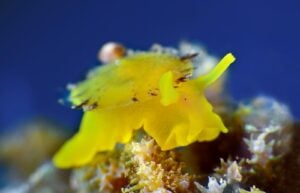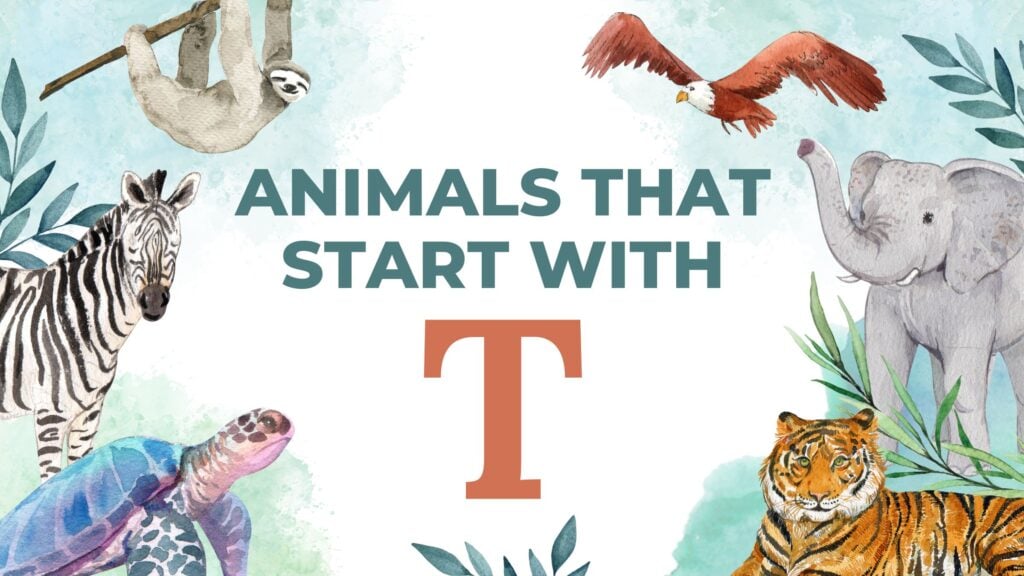
The letter T shows up all over the animal kingdom, in all kinds of species. There are bizarre insects and small fish starting with T, but there are also vibrant birds and massive mammals. No matter what type of animal you love the most, there’s likely something to pique your interest in this category.
Animal lovers, keep reading to meet fascinating creatures from around the world and discover surprising facts about their habitats, daily lives, and what makes them unique.
List of Animals
Here are 99 animal species that start with the letter T.
Click an animal name to jump to its full description, image, and more below.
| Animal | Type | Region |
|---|---|---|
| Taiwan Barbet | Bird | Taiwan |
| Taiwan Blue Magpie | Bird | Taiwan |
| Taiwan Serow | Mammal | Taiwan |
| Takin | Mammal | Eastern Himalayas |
| Talamanca Hummingbird | Bird | Central America |
| Tam Dao Salamander | Amphibian | Vietnam |
| Tammar Wallaby | Mammal | Western Australia |
| Tanzanian Red-Billed Hornbill | Bird | Tanzania |
| Tapanuli Orangutan | Mammal | Indonesia (South Tapanuli) |
| Tasmanian Devil | Mammal | Tasmania |
| Tasmanian Nativehen | Bird | Tasmania |
| Tasmanian Pademelon | Mammal | Tasmania |
| Tasmanian Pygmy Possum | Mammal | Tasmania |
| Tasselled Wobbegong | Fish | Indo-Pacific Ocean |
| Tawny Eagle | Bird | Sub-Saharan Africa, S. Asia |
| Tawny Frogmouth | Bird | Australia |
| Tawny Mining Bee | Insect | Europe |
| Tawny Owl | Bird | Europe, North Africa, Asia |
| Tawny-Browed Owl | Bird | Argentina, Brazil, Paraguay |
| Tayra | Mammal | Central and South America |
| Temminck’s Tragopan | Bird | Southern Asia |
| Ten-Lined June Beetle | Insect | United States, Canada |
| Tench | Fish | Europe, Asia |
| Tenerife Speckled Lizard | Reptile | Spain (Tenerife) |
| Tent-Making Bat | Mammal | Central and South America |
| Texas Banded Gecko | Reptile | United States |
| Texas Blind Salamander | Amphibian | United States (Texas) |
| Texas Brown Tarantula | Arachnid | United States |
| Texas Coral Snake | Reptile | United States (Texas) |
| Texas Horned Lizard | Reptile | United States |
| Texas Night Snake | Reptile | United States, Mexico |
| Texas Spiny Lizard | Reptile | United States, Mexico |
| Thick-Billed Green Pigeon | Bird | Southeast Asia |
| Thick-Billed Parrot | Bird | Mexico |
| Thick-Billed Raven | Bird | Horn of Africa |
| Thick-Billed Spiderhunter | Bird | Southeast Asia |
| Thirteen-Lined Ground Squirrel | Mammal | North America |
| Thomson’s Gazelle | Mammal | East Africa |
| Thornback Ray | Fish | Europe, Western Africa |
| Thorny Devil | Reptile | Australia |
| Thorold’s Deer | Mammal | Tibet |
| Three Spot Gourami | Fish | Southeast Asia |
| Three-Spined Stickleback | Fish | Northern Hemisphere |
| Three-Striped Night Monkey | Mammal | Northern South America |
| Three-Striped Roofed Turtle | Reptile | South Asia |
| Tibetan Fox | Mammal | China (Tibetan Plateau) |
| Tiger | Mammal | Asia |
| Tiger Barb | Fish | Southeast Asia |
| Tiger Quoll | Mammal | Eastern Australia |
| Tiger Rattlesnake | Reptile | United States, Mexico |
| Tiger Salamander | Amphibian | North America |
| Tiger Shark | Fish | Global (Tropical Oceans) |
| Tiger Snake | Reptile | Australia |
| Timber Rattlesnake | Reptile | Eastern United States |
| Timor Python | Reptile | Indonesia |
| Tinfoil Barb | Fish | Southeast Asia |
| Tiny Sunbird | Bird | Central Africa |
| Tire-Track Eel | Fish | Southeast Asia |
| Titan Beetle | Insect | South America |
| Titan Triggerfish | Fish | Indo-Pacific |
| Toco Toucan | Bird | South America |
| Tokay Gecko | Reptile | Southeast Asia |
| Toque Macaque | Mammal | Sri Lanka |
| Torrent Duck | Bird | South America (Andes) |
| Tourmaline Sunangel | Bird | South America (Andes) |
| Townsend’s Big-Eared Bat | Mammal | United States |
| Townsend’s Warbler | Bird | North America |
| Transvaal Dwarf Chameleon | Reptile | South Africa |
| Transvaal Girdled Lizard | Reptile | Southern Africa |
| Tree Bumblebee | Insect | Europe, Asia |
| Tree Pangolin | Mammal | West Africa |
| Tree Swallow | Bird | North America |
| Tricolored Heron | Bird | Americas |
| Tristan Albatross | Bird | Tristan da Cunha Islands |
| Trocaz Pigeon | Bird | Madeira |
| Tropical Parula | Bird | Americas |
| Tropical Screech Owl | Bird | Central and South America |
| Trumpeter Hornbill | Bird | Africa |
| Trumpeter Swan | Bird | North America |
| Tuatara | Reptile | New Zealand |
| Tufted Coquette | Bird | South America |
| Tufted Deer | Mammal | China |
| Tufted Duck | Bird | Northern Eurasia |
| Tufted Puffin | Bird | North Pacific |
| Tufted Titmouse | Bird | United States |
| Tui | Bird | New Zealand |
| Tundra Swan | Bird | North America, Europe, Asia |
| Turbot | Fish | Europe |
| Turkey Vulture | Bird | Americas |
| Turks and Caicos Rock Iguana | Reptile | Caribbean |
| Turnip-Tailed Gecko | Reptile | Central and South America |
| Turquoise Dwarf Gecko | Reptile | Tanzania |
| Turquoise Jay | Bird | South America |
| Turquoise-Browed Motmot | Bird | Central America |
| Turquoise-Fronted Amazon | Bird | South America |
| Twelve-Wired Bird-of-Paradise | Bird | Indonesia, New Guinea |
| Twist-Necked Turtle | Reptile | South America |
| Tyler’s Tree Frog | Amphibian | Australia |
| Typical Striped Grass Mouse | Mammal | Africa |
1. Taiwan Barbet
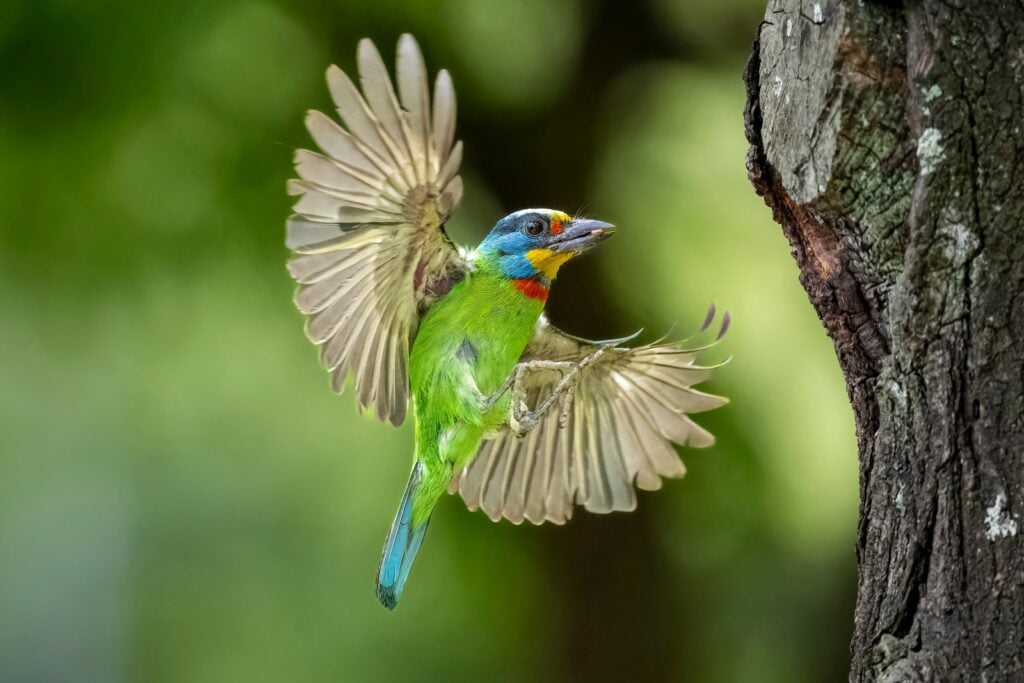
- Scientific Name: Psilopogon nuchalis
- Habitat: High elevation forests of Taiwan
- Size: 7 to 8 inches
- Diet: Fruits, insects
The Taiwan barbet, which is endemic to Taiwan, has a very distinctive appearance. Its body is bright green while the feathers around the face are patches of blue, yellow, and red. These striking colors appear on both males and females. Taiwan barbets live at elevations up to 9,200 feet, and locals sometimes call them “five-colored birds” and “colorful monks.”
2. Taiwan Blue Magpie
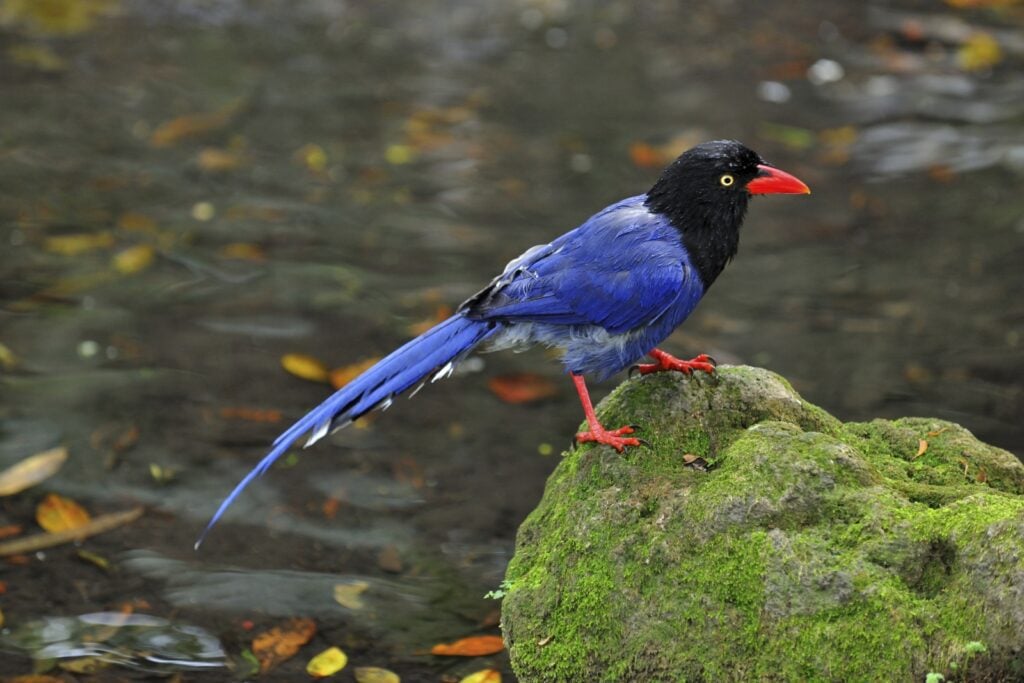
- Scientific Name: Urocissa caerulea
- Habitat: Broadleaf forests of Taiwan
- Size: 25 to 27 inches
- Diet: Insects, fruits, small reptiles, seeds, carrion
While Taiwan blue magpies primarily live in forests, they’re surprisingly brave around humans. They may gather near homes and other populated areas to scavenge for food that humans leave behind. When they fly, they often form a line of several birds in a row. Even though most of their body is solid blue, their heads are sleek black with yellow eyes.
3. Taiwan Serow
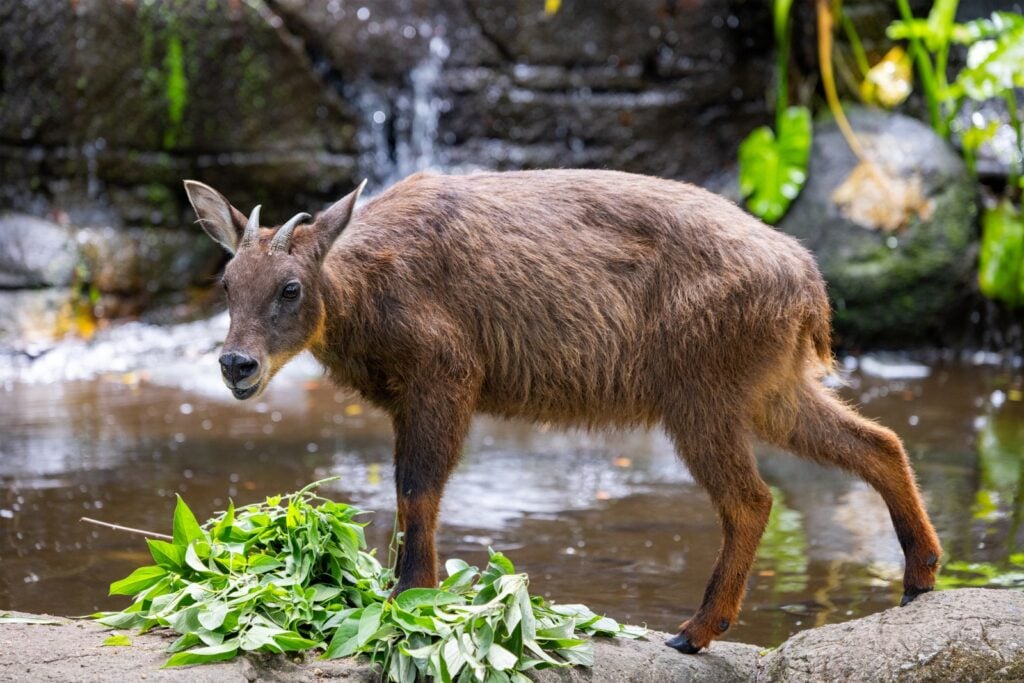
- Scientific Name: Capricornis swinhoei
- Habitat: Forests and steep slopes of Taiwan
- Size: 55 to 77 pounds
- Diet: Leaves, vines, ferns, shrubs, herbs
Serows look like small deer, but they’re not part of the same family. They’re more closely related to goats. Taiwan serows might look cute and docile, but they can be tough. They’re territorial and use scent marking to scare other animals away from their area. They can jump up to 6 feet and run at speeds of up to 34 miles per hour, which helps them escape creatures they perceive as threats.
4. Takin

- Scientific Name: Budorcas taxicolor
- Habitat: Mountainous terrain of the eastern Himalayas
- Size: 400 to 700 pounds
- Diet: Grasses, leaves, bamboo shoots, flowers
These large animals are often referred to as “goat-antelopes.” It’s easy for people to be fooled by their size, but they can be just as agile as their relatives. They’re able to jump over 6-foot barriers without needing a running start. Since they live in cold mountains, they have a thick, secondary coat that they grow out in the winter and shed in the summer. They also use their big sinus cavities to warm up air before it reaches their lungs. These animals aren’t picky, eating at least 130 different plant species.
5. Talamanca Hummingbird
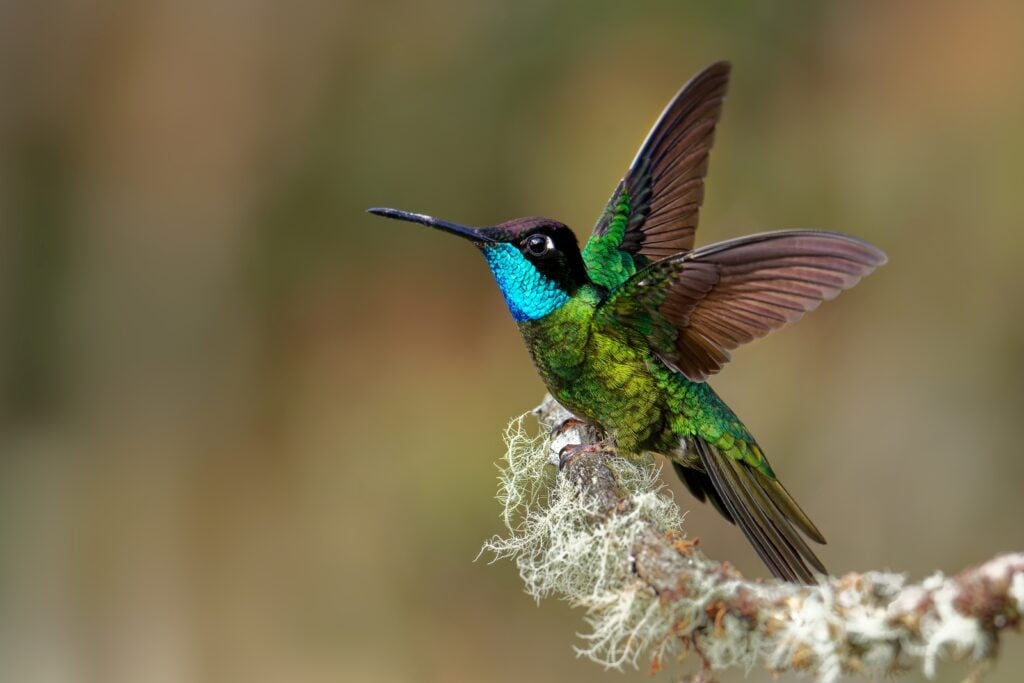
- Scientific Name: Eugenes spectabilis
- Habitat: Oak forests and forest edges from Costa Rice to western Panama
- Size: About 5 inches
- Diet: Nectar
Talamanca hummingbirds might seem small, but they’re larger than most hummingbird species. Their long, narrow bills help them eat nectar, which is their primary food source. However, they may also catch insects in mid-flight if nectar is hard to find. Both males and females have shimmering green and blue feathers, but female feathers are slightly duller.
6. Tam Dao Salamander
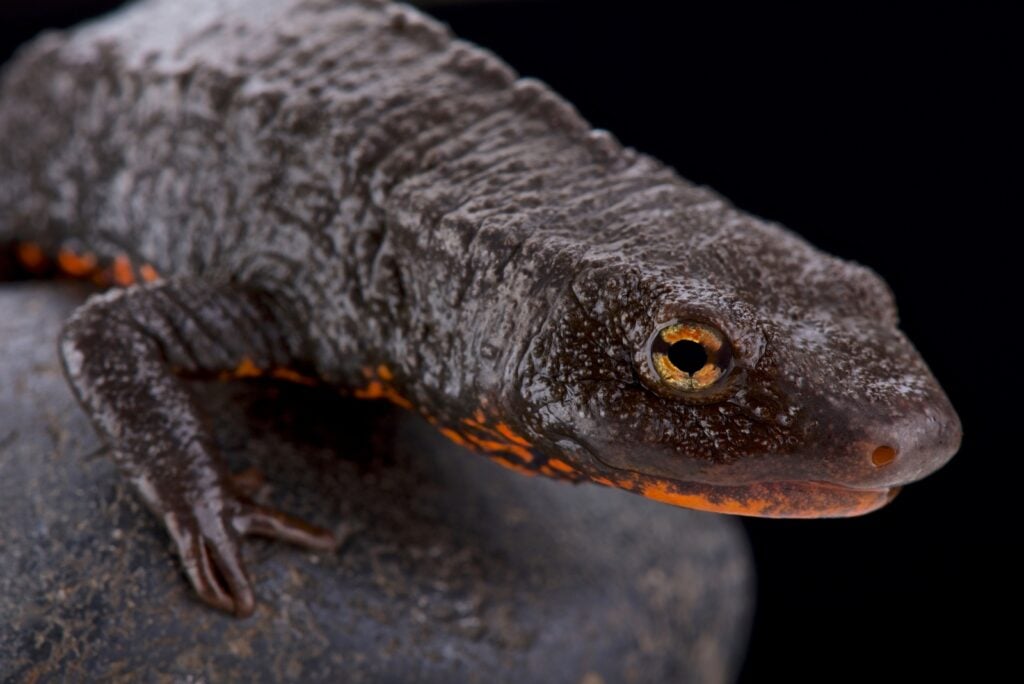
- Scientific Name: Paramesotriton deloustali
- Habitat: Subtropical and tropical moist lowlands of Vietnam
- Size: 4 t 8 inches
- Diet: Insects, worms, other small invertebrates
Tam Dao salamanders, also known as Vietnamese salamanders, share a similar appearance with fire belly newts because they have a dark-colored back and a bright orange belly. Like other amphibians, their skin needs to stay moist for them to thrive, so they stay near rivers and other bodies of water. Sadly, their population is decreasing due to habitat loss and poaching.
7. Tammar Wallaby

- Scientific Name: Macropus eugenii
- Habitat: Coastal shrublands and dry forests of Western Australia
- Size: 15 to 20 pounds
- Diet: Grasses, shrubs, herbs, fruits
This is the smallest wallaby species, but these marsupials have long tails measuring 15 to 17 inches. Their tails are important for stability and balance when hopping, swimming, and sitting still. They typically live in large groups of up to 50 individuals, which are called “mobs.” One mob of tammar wallabies can occupy up to 100 hectares of territory. They’re nocturnal creatures, so they rest in shaded areas during the day.
8. Tanzanian Red-Billed Hornbill

- Scientific Name: Tockus ruahae
- Habitat: Savannas and woodlands of central Tanzania
- Size: 14 to 24 inches
- Diet: Insects, small vertebrates, fruits, seeds
There are several red-billed hornbills that were once considered the same species, but after further research, they were split up into five unique species. Tanzanian red-billed hornbills are small hornbills that have white feathers with black patches, but their most distinguishing feature is their bright red-orange bills. This species differs from the Northern red-billed hornbill in that the birds have black feathers around the eyes, rather than bare skin.
9. Tapanuli Orangutan
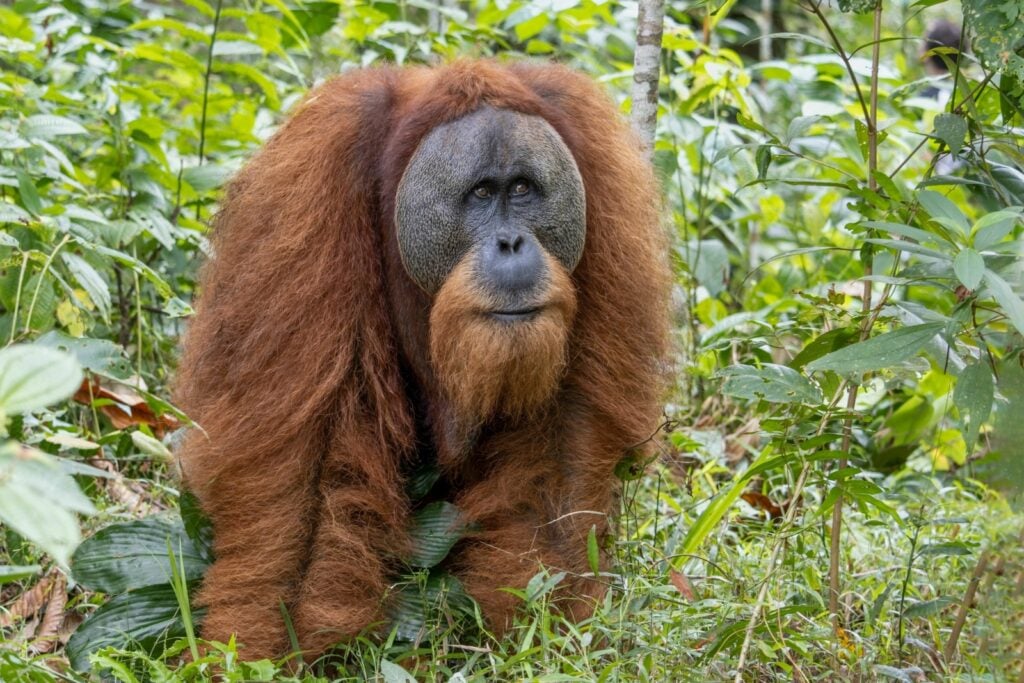
- Scientific Name: Pongo tapanuliensis
- Habitat: Tropical and subtropical broadleaf forests of South Tapanuli, Indonesia
- Size: 66 to 180 pounds
- Diet: Leaves, saplings, buds, tree bark, fruits, insects
Tapanuli orangutans weren’t announced as a unique species of orangutan until 2017, making them the third orangutan species in addition to Sumatran and Bornean orangutans. They make unique sounds compared to the other two, which include long, high-pitched calls. The males of this species are significantly larger than the females, often weighing twice as much. Tapanuli orangutans are the rarest great ape species. In their small range, there are about 800 individuals remaining, making them endangered.
10. Tasmanian Devil
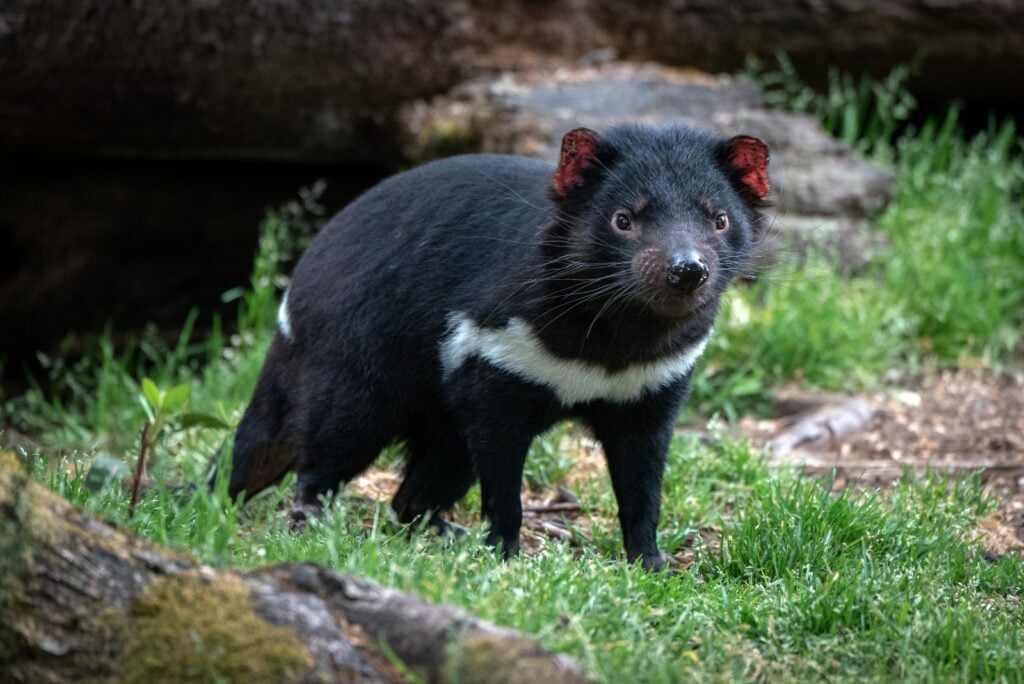
- Scientific Name: Sarcophilus harrisii
- Habitat: Forests and woodlands of Tasmania
- Size: 11 to 30 pounds
- Diet: Carrion, small mammals, birds
As awesome as the spinning Looney Tunes character is, real Tasmanian devils are very different. They’re furry, black creatures about the size of a small dog. While they’re adorable, they’re also strong and ferocious. Their bites are strong enough to crush bones, and they can even bite through metal to reach livestock. They earned the name “devils” because they make blood-curdling shrieks, which are used to scare off other animals (but they can be frightening for humans too).
11. Tasmanian Nativehen
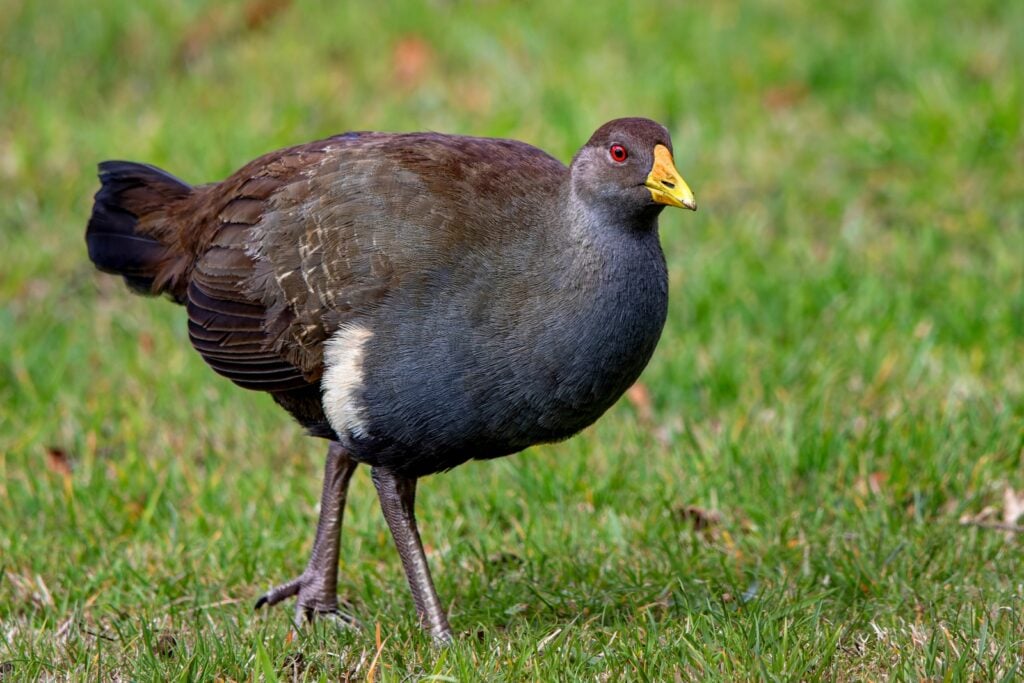
- Scientific Name: Tribonyx mortierii
- Habitat: Open pastures and grasslands of Tasmania
- Size: 17 to 20 inches
- Diet: Seeds, leaves, other vegetation, insects
Tasmanian nativehens were once common across Australia’s mainland, but today, they only appear on the island of Tasmania. Their extinction on the mainland is likely due to a rise in predators like dingoes. These birds have strong legs, allowing them to run 31 miles per hour and even swim to escape predators if needed. They’re very vocal, using at least 14 unique calls to interact with others of their species, including a loud, rasping sound similar to the noise of someone cutting metal.
12. Tasmanian Pademelon

- Scientific Name: Thylogale billardierii
- Habitat: Dense vegetation of Tasmania
- Size: 9 to 25 pounds
- Diet: Herbs, grasses, shoots, other plants
Tasmanian pademelons are small marsupials, meaning they have a pouch to carry their young like kangaroos. These creatures are solitary, but both males and females have multiple mates. There isn’t a specific breeding season, but most young pademelons are born at the beginning of winter. Tasmanian pademelons are nocturnal and hide in dense vegetation during the day. After dusk, they feed in open areas, and they rarely travel more than 300 feet when feeding.
13. Tasmanian Pygmy Possum
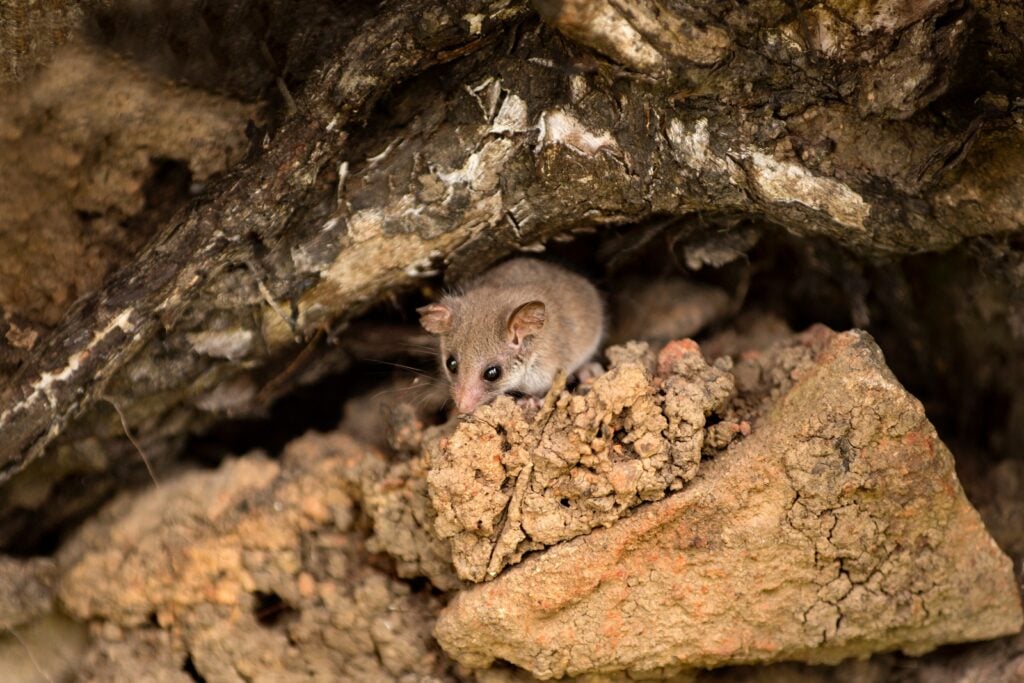
- Scientific Name: Cercartetus lepidus
- Habitat: Shrublands and forest undergrowth of Tasmania
- Size: 2.4 to 3 inches
- Diet: Insects, spiders, nectar, pollen, small lizards
While these tiny mammals closely resemble mice, they’re marsupials rather than rodents. They spend most of their time in the trees, and they have a prehensile tail that allows them to grab things. They’re good climbers, but they typically stick to lower branches. They build dome-like nests inside tree cavities and rotten wood using tree bark. They spend most of their time alone, only sharing nests with their young.
14. Tasselled Wobbegong
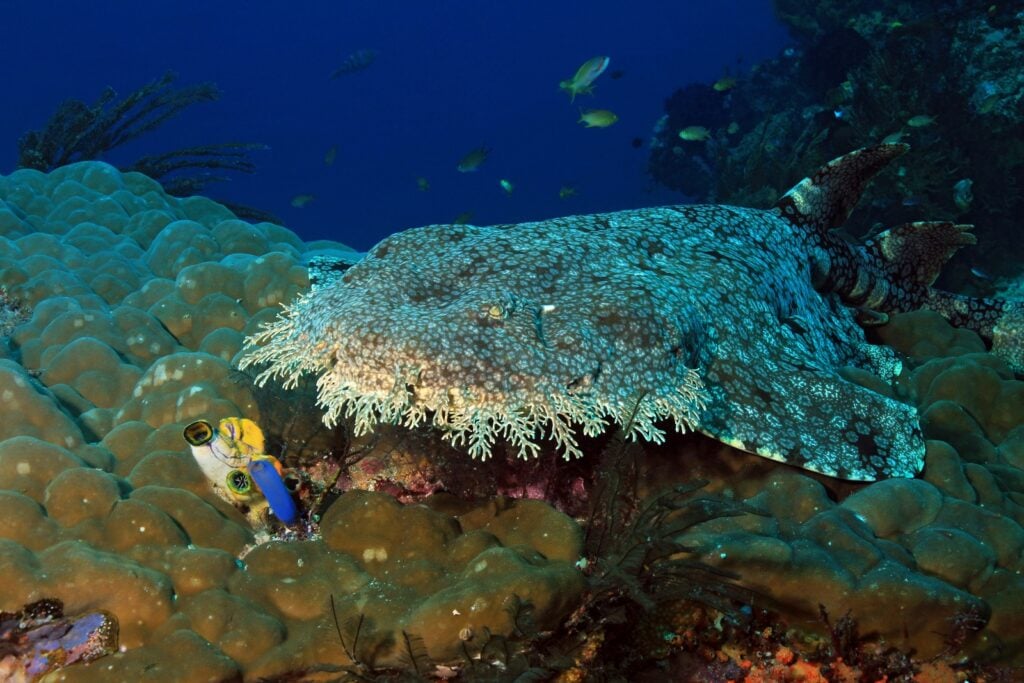
- Scientific Name: Eucrossorhinus dasypogon
- Habitat: Tropical waters of the Indo-Pacific Ocean
- Size: 4 to 6 feet
- Diet: Bottom-dwelling fish, invertebrates, and other sharks
Tasselled wobbegongs might look like rocks with aquatic plants on the edge, but they’re actually a shark species. Their unique appearance offers perfect camouflage, allowing them to sit still and wait for prey to approach before ambushing. They sometimes eat other sharks, including one report when a tasselled wobbegong hunted and ate a brown-banded bamboo shark that was 80% its size. This species’ unique name comes from the Australian Aboriginal language, and it’s thought to mean “shaggy beard” or “living rock.”
15. Tawny Eagle

- Scientific Name: Aquila rapax
- Habitat: Open, dry habitats of sub-Saharan Africa and southern Asia
- Size: 2.1 to 2.4 feet
- Diet: Carrion, small mammals, birds, reptiles
Tawny eagles are powerful birds capable of hunting animals up to twice their weight. However, they’re also opportunistic hunters, so they will feed on carrion instead of hunting when that’s an option. They eat a wide range of animals, but no animals hunt them, so their only threat is humans. They can fly over 14,000 feet in the air, allowing them to find high perches to sit on while searching for nearby prey.
16. Tawny Frogmouth
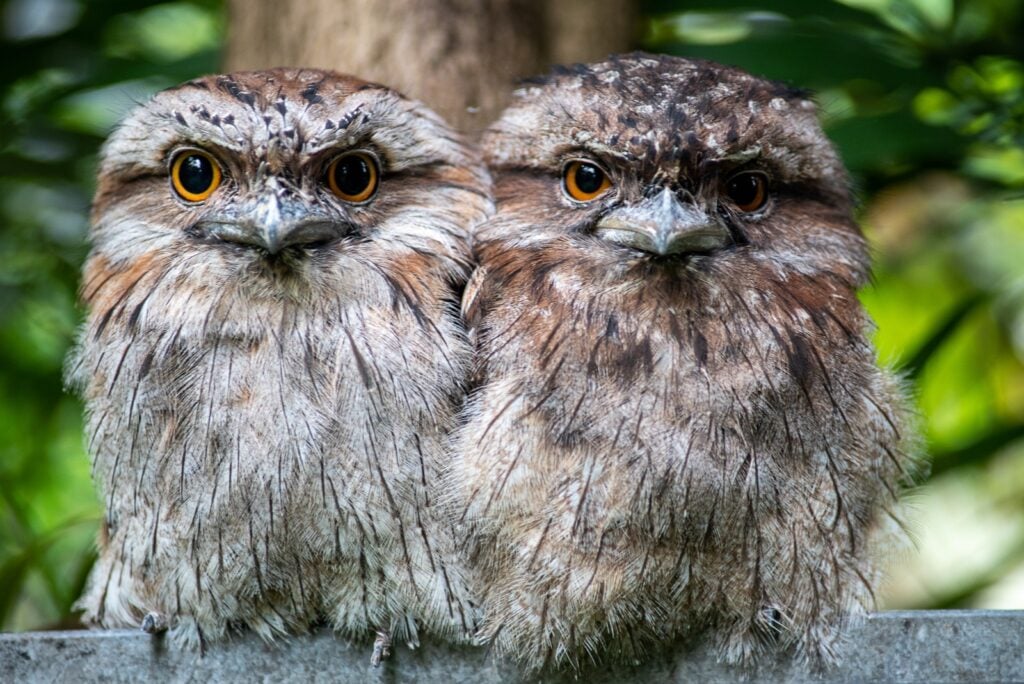
- Scientific Name: Podargus strigoides
- Habitat: Woodlands, forests, and scrublands of Australian, including Tasmania
- Size: 9 to 21 inches
- Diet: Insects, worms, slugs, snails
Tawny frogmouths resemble owls, but they’re actually more closely related to nightjars. Their unique appearance allows them to stiffen their bodies and make themselves look like branches when they feel threatened. Their large mouth gives them a frog-like appearance, and opening their mouth helps them capture prey and intimidate predators. They also have long, thin tongues like frogs, which can assist in hunting prey.
17. Tawny Mining Bee
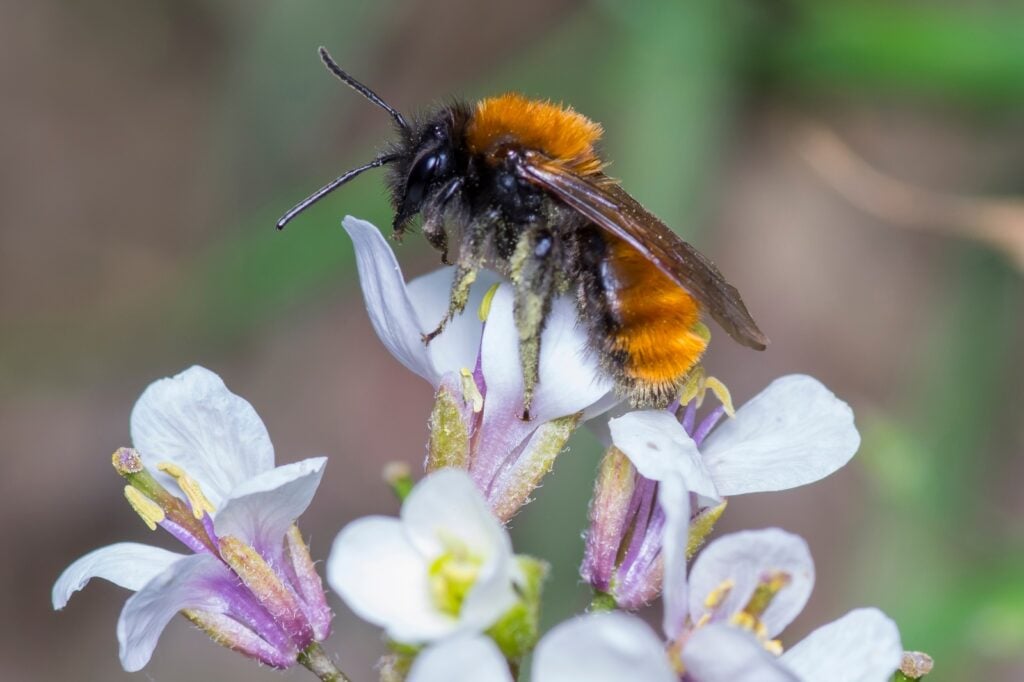
- Scientific Name: Andrena fulva
- Habitat: Gardens, meadows, and woodlands across parts of Europe
- Size: 0.3 to 0.5 inches
- Diet: Pollen, nectar
Tawny mining bees have a beautiful ginger color rather than bright yellow. Females have darker coloring than males, which closely resembles the reddish-orange fur found on foxes. They build piles of soil to burrow in, which offer drainage and aeration to lawns. Unlike other bees, tawny mining bees are solitary and rarely form colonies. They’re amazing pollinators and rarely act aggressively unless threatened.
18. Tawny Owl

- Scientific Name: Strix aluco
- Habitat: Woodlands across Europe, North Africa, and Western and Central Asia
- Size: 15 to 18 inches
- Diet: Rodents, rabbits, birds, frogs, insects, worms, fish
Despite having such a large range, tawny owls can be hard to spot since they’re only active at night. They sleep in tree hole nests when the sun is out. On rare occasions, the males may hunt during daylight amid the breeding season to provide for their mates. These owls typically avoid flying over water, so they rarely appear on islands. While they have an adorable appearance, they can be highly aggressive and have caused injuries to humans who got too close to nests.
19. Tawny-Browed Owl

- Scientific Name: Pulsatrix koeniswaldiana
- Habitat: Humid tropical forests and open woodlands of Argentina, Brazil, and Paraguay
- Size: About 17 inches
- Diet: Small mammals, birds, insects
Despite having a similar name, tawny-browed owls have a very different range and appearance compared to tawny owls. They have light brown “eyebrows” amid their dark brown feathers, making it look like they’re always angry. As chicks, these owls are almost completely white, and they slowly gain their unique coloring as they age. They’re nocturnal and secretive, spending time hunting from perches after the sun sets.
20. Tayra
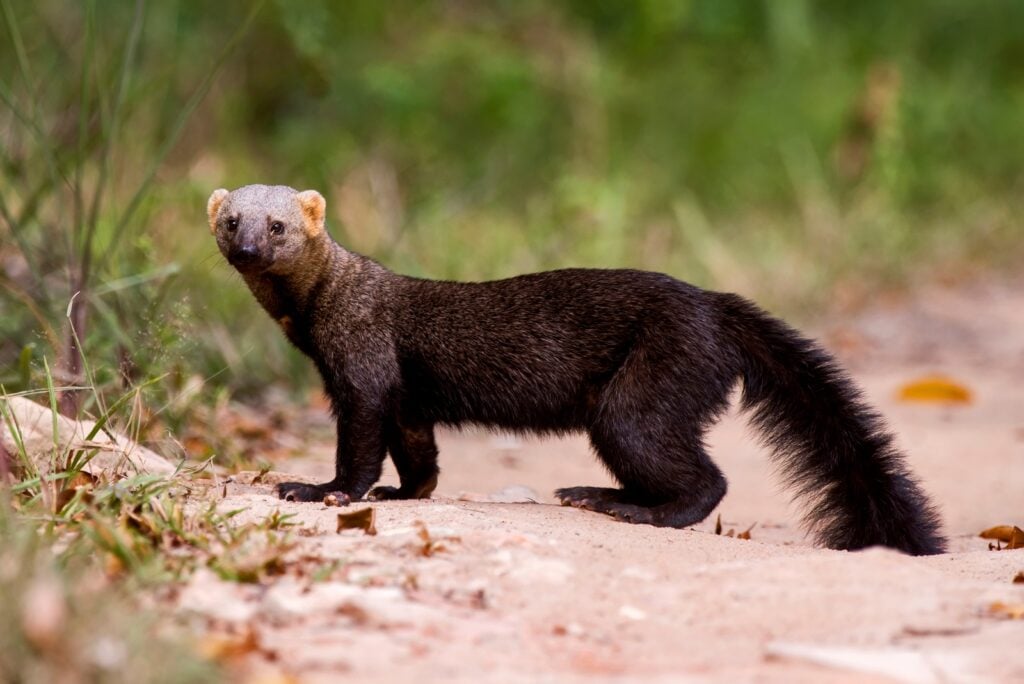
- Scientific Name: Eira barbara
- Habitat: Forests across Central and South America
- Size: 6 to 15 pounds
- Diet: Rodents, other small mammals, birds, lizards, invertebrates
Tayras are small mammals with long bodies, resembling mini wolverines. They’re excellent climbers, using their tails to help them balance as they navigate through the tree canopies. They have a strong sense of smell, so once they locate prey, they quickly chase it down rather than ambushing it. These creatures are shy toward humans, avoiding them as much as possible. They may growl or shriek if they feel threatened.
21. Temminck’s Tragopan
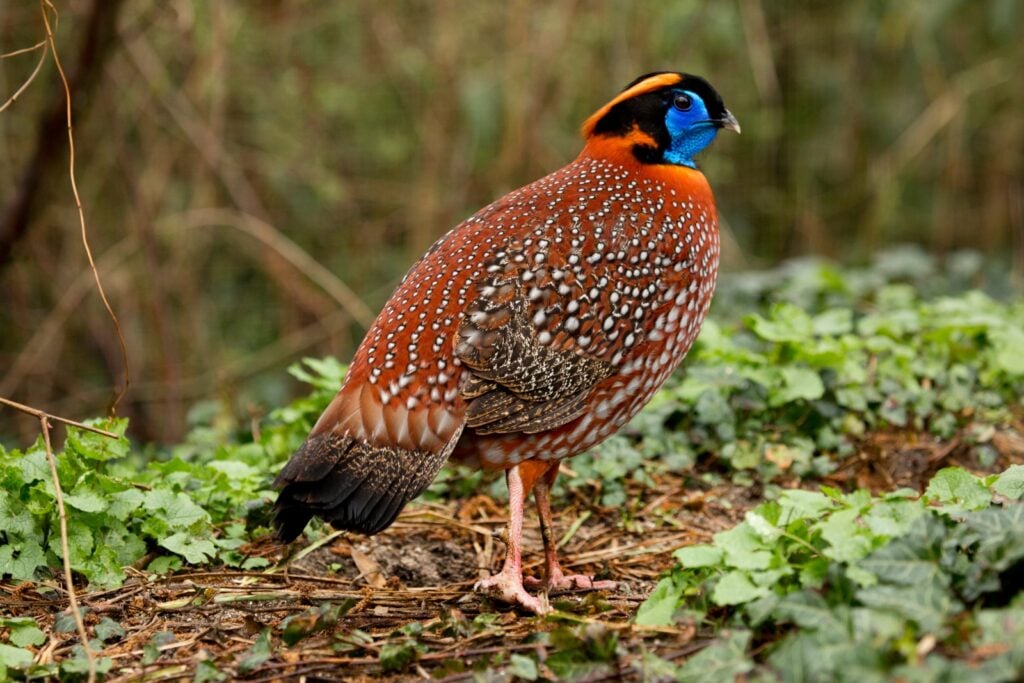
- Scientific Name: Tragopan temminckii
- Habitat: Dense evergreen forests of southern Asia
- Size: 22 to 25 inches
- Diet: Berries, grass, other plants
While most pheasants nest on the ground, Temminck’s tragopans nest in trees. They can fly short distances, allowing them to quickly retreat to their nesting trees when threatened. Young birds of this species develop quickly and can fly only a few days after hatching. Both males and females have beautiful speckled feathers, but females are brown while males have rust-colored bodies and blue faces.
22. Ten-Lined June Beetle

- Scientific Name: Polyphylla decemlineata
- Habitat: Forests, farmlands, and gardens across the United States and Canada
- Size: 0.8 to 1.5 inches
- Diet: Plant roots, foliage
Ten-lined June beetles can be destructive to crops because the larvae feed on roots, which can weaken and kill the plants. While the adults still feed on plant matter, they don’t cause destruction. If disturbed, the adult beetles may make a hissing sound by pushing their wings down and forcing air out. While these insects can live for four years, they spend most of their lives as larvae.
23. Tench
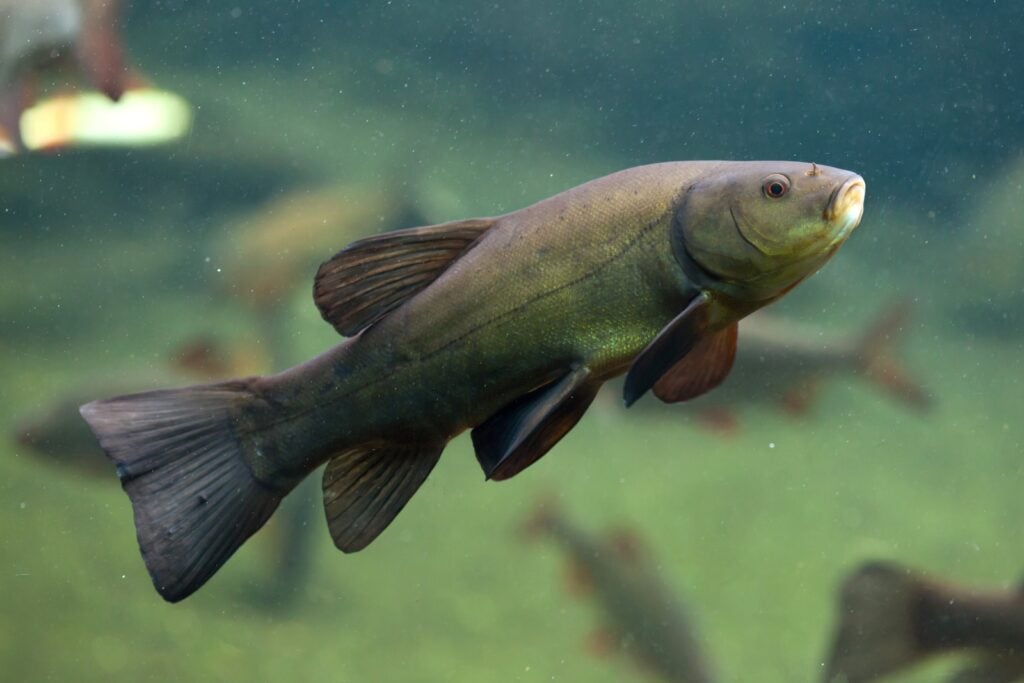
- Scientific Name: Tinca tinca
- Habitat: Shallow lakes and rivers of Europe and parts of Asia
- Size: 16 to 30 inches
- Diet: Aquatic invertebrates, fish eggs, plant matter
Outside of Europe and Asia, tench have become invasive in other areas like Canada. People imported them to a farm in Quebec, and they escaped and reproduced in North America. They may compete with native fish and stir up substrate when feeding, hurting the water quality and habitats. They’re nicknamed the doctor fish because people have used their slime for medicine. Their slime also makes them immune to certain bacteria, making them more hardy than other fish.
24. Tenerife Speckled Lizard

- Scientific Name: Gallotia intermedia
- Habitat: Rugged terrain of Tenerife, Spain
- Size: 12 t0 16 inches
- Diet: Plant matter
The Tenerife speckled lizard is a relatively new discovery, with the first reported sighting in 1996. These lizards were first found near Macizo de Teno, which is a volcano formation far north on the island of Tenerife. Not much is known about this species, but the lizards are typically seen among rocks and boulders. They’re mostly gray like the rocks around them, but they sometimes have pale blue patches.
25. Tent-Making Bat
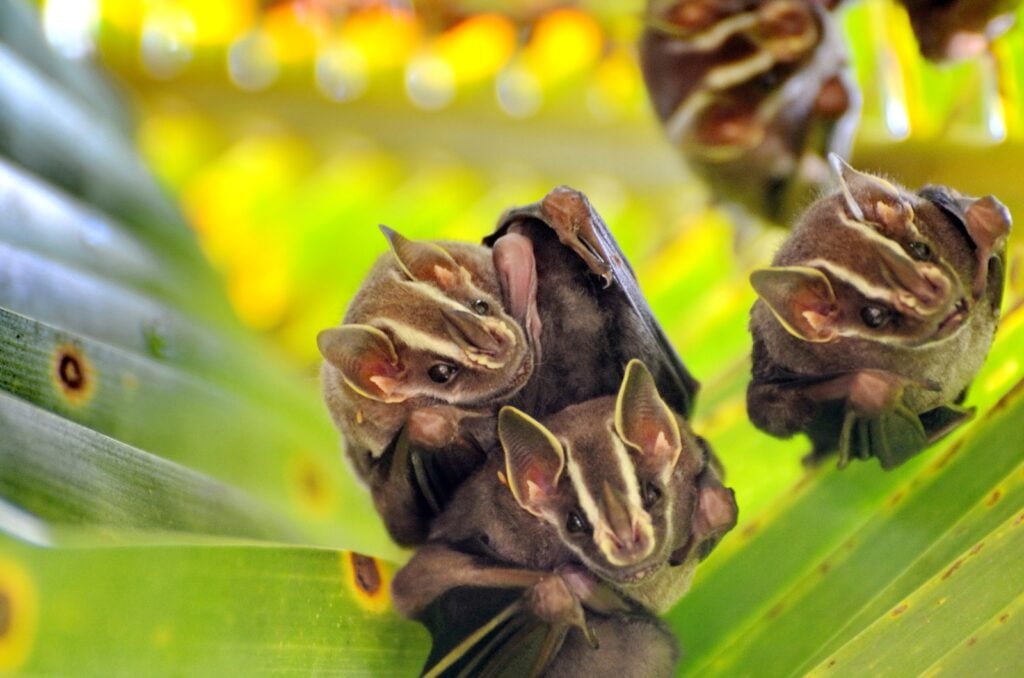
- Scientific Name: Uroderma bilobatum
- Habitat: Lowland forests of Central and South America
- Size: 2.3 to 2.7 inches
- Diet: Fruit, pollen, nectar, insects
Tent-making bats earned their name from the way they build tent-like structures out of leaves. They rip part of a large leaf so it folds over them for shelter. Anywhere from 2 to 59 bats will gather under the same shelter. These little bats may use the same tent for up to 60 days. Honduran white bats, another tiny bat species, also display this tent-building behavior.
26. Texas Banded Gecko
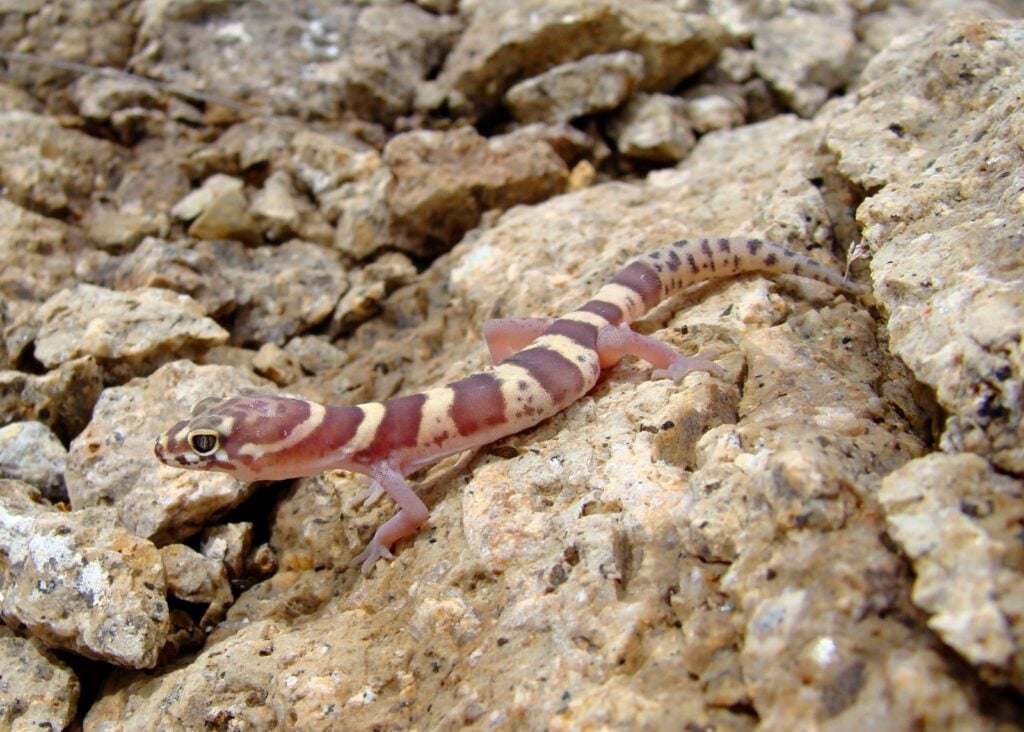
- Scientific Name: Coleonyx brevis
- Habitat: Arid, rocky regions of Texas and southern New Mexico
- Size: 4 to 5 inches
- Diet: Insects, spiders, other invertebrates
These little lizards have smooth, pale skin with distinct stripes. If they feel threatened, they may lift their tails above their bodies to appear intimidating. They may also make high-pitched squeaks when startled. They’re not as good at climbing as other geckos, so they hunt on the ground of rocky areas rather than climbing trees. They’re nocturnal creatures that hide in the shade of rock formations during the day to keep cool and rest.
27. Texas Blind Salamander
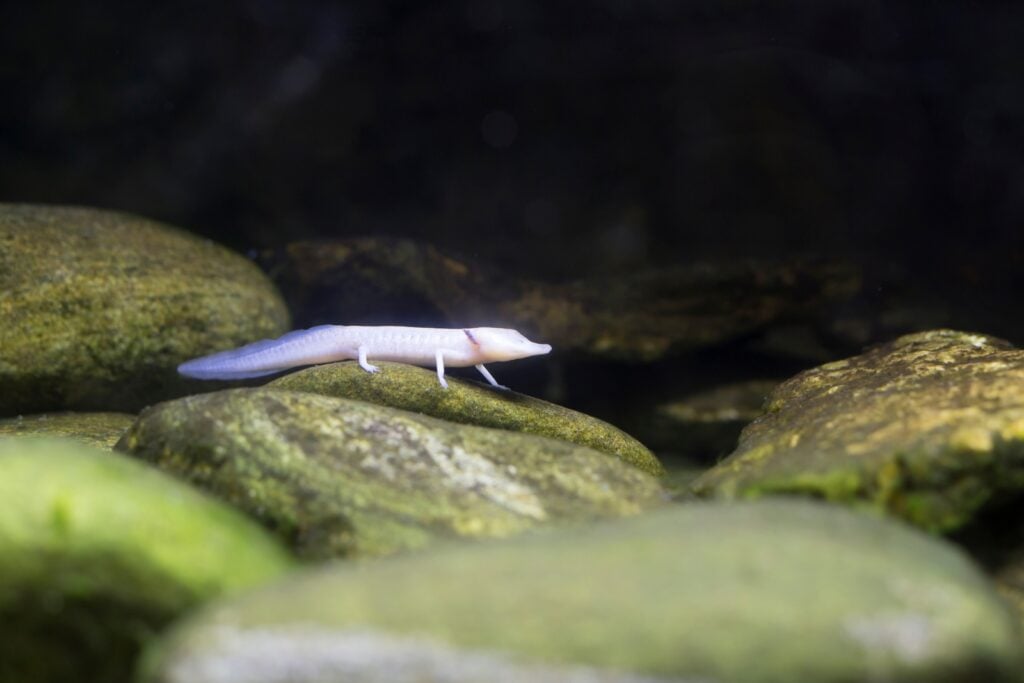
- Scientific Name: Eurycea rathbuni
- Habitat: Water-filled caves near San Marcos, Texas
- Size: 4 to 5 inches
- Diet: Small snails, shrimp, other aquatic invertebrates
The Texas blind salamander is an aquatic salamander similar to an axolotl or olm. These critters have fluffy external gills to help them breathe underwater. Most salamanders have these gills only as larvae, but Texas blind salamanders never grow out of them. While these amphibians can’t see, they hunt by sensing water movements created by prey. These bizarre animals are extremely rare, so it’s unclear how many remain in the wild.
28. Texas Brown Tarantula

- Scientific Name: Aphonopelma hentzi
- Habitat: Grasslands, deserts, and prairies of the south central United States
- Size: 4 to 5 inch leg span
- Diet: Insects, small vertebrates
While Texas brown tarantulas are venomous, their venom typically isn’t harmful to humans. Bites can cause some pain and swelling, but it doesn’t cause any major medical concerns. Some people have compared the pain to a bee sting. Unlike smaller spiders, these tarantulas don’t spin webs. Instead, they grab their prey while walking on the ground. Their venom can subdue small animals, making the prey easier for the tarantulas to digest.
29. Texas Coral Snake

- Scientific Name: Micrurus tener
- Habitat: Forests, grasslands, and deserts of southern Texas
- Size: 2 to 3 feet long
- Diet: Small snakes, lizards, frogs, rodents, birds
Not only are Texas coral snakes venomous, but they can be deadly to humans. People bitten by these snakes are typically ill for several days, and they may experience respiratory issues, along with weakness, dizziness, and vision problems. Luckily, these snakes are shy and secretive, so they don’t come into contact with humans. They’re also nocturnal and solitary. Less than 1% of the snake bites in America are caused by these reptiles.
30. Texas Horned Lizard

- Scientific Name: Phrynosoma cornutum
- Habitat: Arid and semi-arid areas of Texas and bordering states
- Size: 3.7 to 5 inches
- Diet: Ants, other insects
Texas horned lizards primarily feed on harvester ants, which helps keep the harvester ant population under control. While these reptiles can feed on other insects too, their population greatly decreases when there are fewer ants available. Like other horned lizards, they have the unique ability to squirt blood from the corners of their eyes. This startles predators while also leaving a foul taste behind. To squirt blood, the lizards restrict the blood flow, leaving their heads to rupture vessels near the eyelids.
31. Texas Night Snake

- Scientific Name: Hypsiglena jani
- Habitat: Dry, rocky habitats of southwestern United States and northern Mexico
- Size: 10 to 16 inches long
- Diet: Lizards, frogs, insects, small snakes
Texas night snakes are small, non-venomous snakes that typically only come out at night. Their bodies have gray and/or brown scales that blend in well with the rocky environment around them. The narrow, vertical pupils of these snakes help them see better in the dark. As soon as young Texas night snakes hatch, they need to immediately start hunting for themselves without any help from their parents.
32. Texas Spiny Lizard

- Scientific Name: Sceloporus olivaceus
- Habitat: Forests and shrublands of south central United States and northern Mexico
- Size: 8 to 12 inches
- Diet: Insects
Texas spiny lizards are territorial toward other lizards. When males challenge each other, they appear to have a push-up competition. Both lizards keep doing a push-up motion until one of them gives up and scurries away. While they’re brave toward each other, they’re typically shy around humans, quickly climbing up a tree to keep a distance. Their spiky brown scales make them blend in perfectly with tree bark.
33. Thick-Billed Green Pigeon

- Scientific Name: Treron curvirostra
- Habitat: Forests of southeast Asia
- Size: Up to 10 inches
- Diet: Fruits, seeds
Females of this species are green all over, while males have maroon feathers on their backs. However, both males and females have a bright yellow stripe on their wings. They typically flock in groups to fruit trees, where they make rising and falling “woo” sounds. They primarily feed on fruits, especially the hollow, fleshy parts of figs.
34. Thick-Billed Parrot

- Scientific Name: Rhynchopsitta pachyrhyncha
- Habitat: High-elevation forests of northwestern Mexico
- Size: 15 to 17 inches
- Diet: Pine seeds, other seeds, berries, insects, tree bark
These parrots have thick, strong bills because they primarily eat pine seeds, so they need to shred pine cones with their bills to reach the seeds. Their bills also come in handy for chewing the wood around woodpecker holes to make nests. They’re chatty, social birds, and you can hear their calls from a mile away. They live in flocks together year-round, gathering at elevations between 3,900 and 11,500 feet.
35. Thick-Billed Raven

- Scientific Name: Corvus crassirostris
- Habitat: Most habitats of Eritrea, Somalia, and Ethiopia
- Size: About 25 inches
- Diet: Grubs, carrion, berries, human food
Thick-billed ravens have the largest bill in the passerine family (a group of perching birds). The bill measures 3.1 to 3.5 inches long, and it helps them dig up food and move objects to uncover hidden food. They’re highly intelligent creatures, showing some problem-solving skills when trying to find their meals. They often gather in groups when feeding, and they use a variety of sounds to communicate with each other, including croaks, wheezes, and even mimicked noises.
36. Thick-Billed Spiderhunter

- Scientific Name: Arachnothera crassirostris
- Habitat: Tropical, moist lowland forests of Brunei, Indonesia, Malaysia, Singapore, and Thailand
- Size: 6.3 to 6.7 inches
- Diet: Insects, spiders, nectar
Thick-billed spiderhunters have olive green feathers with long, curved beaks to help them feed on nectar. Their bills are almost half the length of their bodies. In addition to flower nectar, they also forage for insects and spiders among the rainforest canopy. They make nasally chattering sounds that are surprisingly loud for their size.
37. Thirteen-Lined Ground Squirrel

- Scientific Name: Ictidomys tridecemlineatus
- Habitat: Open areas of central North America
- Size: 7 to 12 inches
- Diet: Vegetation, seeds, insects
The thirteen lines on the back of these rodents alternate between dotted lines and solid lines. The squirrels dig burrows and tunnels for resting and to help them escape predators. They hibernate in those burrows during the winter to survive frigid temperatures, and their body temperature drops to just above freezing during that time. They store lots of food prior to hibernating so they can immediately eat when they wake up from hibernation.
38. Thomson’s Gazelle

- Scientific Name: Eudorcas thomsonii
- Habitat: Savannas and grasslands of East Africa
- Size: 33 to 77 pounds
- Diet: Grasses, shrubs, leaves, shoots, seeds, twigs
Thomson’s gazelles, also known as Tommies, typically live in groups of 100, but that number can grow to the thousands when migrating. These mammals often swing their tails back and forth like a windshield wiper, which helps them communicate with each other. They seek out the greenest grasses to eat, which allows them to get plenty of water so they can go for long periods without drinking.
39. Thornback Ray

- Scientific Name: Raja clavata
- Habitat: Shallow, coastal waters of Europe and western Africa
- Size: About 3 feet
- Diet: Crustaceans, small fish, cephalopods
Thornback rays are technically skates instead of stingrays because they have spikes on their backs rather than a stinger on their tails. While it can be painful to accidentally step on one, they don’t have venom like many other rays. These creatures have powerful jaws, allowing them to crush the hard exteriors of crustaceans. They’re not picky, so they may hunt any critters that swim too close, including fish.
40. Thorny Devil

- Scientific Name: Moloch horridus
- Habitat: Arid and semi-arid habitats of central Australia
- Size: 6 to 8.5 inches
- Diet: Ants
Thorny devils look like horned lizards, but they can’t squirt blood from their eyes like their bizarre relatives. Their rough appearance makes predators think twice before hunting them. Depending on the weather, their coloring might change slightly, such as yellow and red tints when warm and darker colors when cold. They have a very specific diet that only includes ants. These spiky reptiles can eat thousands of ants a day. They wait near ant trails and grab the tiny ants with their sticky tongues.
41. Thorold’s Deer

- Scientific Name: Cervus albirostris
- Habitat: Grasslands, shrublands, and forests of Tibet
- Size: 200 to 500 pounds
- Diet: Grasses, sedges, other foliage
This is a massive deer species, and the males are about twice the weight of females. They have a solid gray-brown coat, which is paler in the winter. Herds of up to 100 individuals have appeared before, but groups of 10 or fewer are much more common. They make a wide variety of sounds to communicate with each other, including grunts, snaps, and loud alarm calls. They don’t run much, but when they do, they can reach speeds of 35 miles per hour.
42. Three Spot Gourami

- Scientific Name: Trichopodus trichopterus
- Habitat: Slow-moving freshwater habitats of southeastern Asia
- Size: 4 to 6 inches
- Diet: Zooplankton, insect larvae, crustaceans
The name of this fish is confusing because they typically only have two dark spots on each side of their bodies. However, their eyes are considered the third spot. They’re native to southeastern Asia, but some have been introduced to other areas since they’re popular fish in the pet trade. When they reproduce, the male creates a bubble nest for the eggs, and he becomes very territorial of the nest.
43. Three-Spined Stickleback

- Scientific Name: Gasterosteus aculeatus
- Habitat: Ponds, lakes, and rivers across parts of the Northern Hemisphere
- Size: 1 to 4 inches
- Diet: Small crustaceans, worms, insect larvae
Three-spined sticklebacks have spikes that stick up on their backs. They can hold these spines in an upright position to prevent predators from swallowing them. They’re typically a mix of silver, green, and yellow, but males develop bright red bellies in the spring to help them attract mates. Depending on the location, these fish may migrate in the winter while others remain in the same area year-round.
44. Three-Striped Night Monkey

- Scientific Name: Aotus trivirgatus
- Habitat: Forests north of the Amazon River
- Size: 9.5 to 18.5 inches
- Diet: Fruits, insects, nectar, leaves, tree frogs
The three-striped night monkey, also known as the northern night monkey and northern owl monkey, has massive owl-like eyes for enhanced night vision. However, the structure of their eyes indicates that their ancestors may have once been diurnal. These monkeys start foraging shortly after sunset and remain active all night. They’re able to feed themselves almost immediately after birth. They’re social creatures, and they have one grooming claw on each foot for grooming each other.
45. Three-Striped Roofed Turtle

- Scientific Name: Batagur dhongoka
- Habitat: Large rivers and sand banks of Bangladesh, India, and Nepal
- Size: 22 to 44 pounds
- Diet: Aquatic vegetation, insects, small fish
These are large turtles that have three dark stripes on their shells, which are present as soon as they hatch. They spend most of their time in slow-moving rivers, and they come to sandy river edges to lay their eggs. When breeding begins, males fight over who gets to mate with the female turtle. Sadly, these unique turtles are currently endangered due to habitat destruction, hunting, and the pet trade.
46. Tibetan Fox

- Scientific Name: Vulpes ferrilata
- Habitat: High altitudes of the Tibetan Plateau in China
- Size: 9 to 12 pounds
- Diet: Small mammals, lizards, carcasses
Tibetan foxes stand out because of their unique square heads and sad eyes. Their facial shape may help them navigate through heavy winds. While these foxes look like they’d be clumsy, they’re agile hunters that can eat about 10 pikas per day. They often share the animals they catch with their families. Some Tibetan foxes even work with bears while hunting by grabbing escaping prey while the bear digs. These foxes stay with the same mate for life.
47. Tiger

- Scientific Name: Panthera tigris
- Habitat: Rainforests, mangrove swamps, grasslands, and savannas across parts of Asia
- Size: 220 to 660 pounds
- Diet: Large mammals, birds, reptiles, fish
Tigers are the largest feline species, with Amur tigers being the heaviest subspecies. They’re complete carnivores, mostly feeding on large animals like deer, boar, antelope, and buffalo. One in ten hunts is successful, but luckily, one large deer can feed an adult tiger for a week. Tigers can run 30 to 40 miles per hour when chasing down prey. Every tiger has a unique stripe pattern, much like the uniqueness of human fingerprints.
48. Tiger Barb

- Scientific Name: Puntigrus tetrazona
- Habitat: Freshwater of Southeast Asia
- Size: 1 to 3 inches
- Diet: Plankton, small invertebrates, algae
These small fish resemble the coloring of a tiger because of their light orange bodies with dark stripes. However, the water temperature can affect their coloring. If the water is colder than normal, their stripes may dim, and they may gain a darker body color. These fish typically travel in groups of six or more. In smaller groups, they may become aggressive and nip at each other’s fins.
49. Tiger Quoll

- Scientific Name: Dasyurus maculatus
- Habitat: Forests of eastern Australia
- Size: 4 to 8 pounds
- Diet: Small mammals, birds, insects
Quolls are carnivorous, primarily nocturnal marsupials. Tiger quolls have the second strongest bite force of any predatory mammal, after the Tasmanian devil, so don’t let their charming appearance fool you. Luckily, they only use their powerful jaws for prey and typically avoid humans. When tiger quolls give birth, their joeys are only the size of a grain of rice at first. The tiny joeys stay in the mother’s pouch for about 12 weeks as they develop further.
50. Tiger Rattlesnake

- Scientific Name: Crotalus tigris
- Habitat: Rocky deserts of southwestern United States and northwestern Mexico
- Size: 1.5 to 3 feet long
- Diet: Rodents, lizards
Tiger rattlesnakes have some of the most toxic venom of all rattlesnakes. They have long, hollow fangs that can retract. If bitten by one of these snakes, a person could face paralysis or even death. They’re mild-tempered and nocturnal, so bites to humans are rare. The brown striped pattern of these snakes helps them blend into their rocky environment, allowing them to sit and wait before ambushing prey. These snakes are born without rattles, so the end of their tails develops each time they shed their skin.
51. Tiger Salamander

- Scientific Name: Ambystoma tigrinum
- Habitat: Marshes, meadows, and forests across central North America
- Size: 6 to 14 inches
- Diet: Insects, worms, slugs, small amphibians
Tiger salamanders are a popular species of mole salamander, so they frequently burrow like moles. Their burrows can reach up to two feet below the surface. In the winter, they stay in their burrows and freeze until the weather warms up again in the spring. Tiger salamander larvae are fully aquatic and have fuzzy gills, causing them to get mistaken for axolotls despite being native to a completely different range.
52. Tiger Shark

- Scientific Name: Galeocerdo cuvier
- Habitat: Tropical and warm-temperate waters of the Atlantic, Pacific, and Indian Oceans
- Size: 10 to 14 feet, 850 to 1,400 pounds
- Diet: Fish, crustaceans, cephalopods, other sharks, marine birds, rays, porpoises
Tiger sharks will eat almost anything they can fit in their mouth. This includes a wide range of aquatic animals, including other sharks, but also license plates, tires, and other trash. They have excellent night vision and can detect electric fields, making it easier for them to find prey. Even though they’re not picky with food, they prefer not to eat humans. After all, most reported tiger shark bites weren’t fatal.
53. Tiger Snake
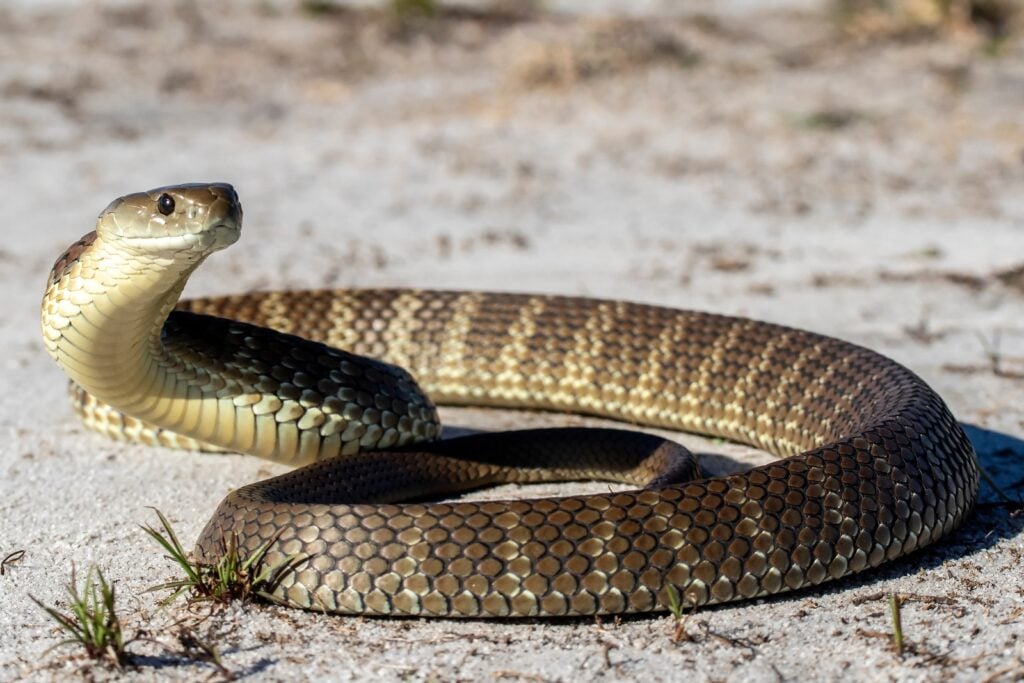
- Scientific Name: Notechis scutatus
- Habitat: Forests, wetlands, and grasslands of southern Australia
- Size: 3 to 7 feet long
- Diet: Fish, frogs, lizards, small mammals, birds, carrion
These Australian snakes are highly venomous. A bite can cause pain, swelling, blood clotting, and paralysis. More often than not, they will escape conflict rather than striking. These snakes typically hunt for prey during the day, and they eat almost any small animals they can find. They’re capable of staying underwater for at least nine minutes, so they often hunt aquatic prey. The size of these snakes varies greatly depending on the available prey size.
54. Timber Rattlesnake

- Scientific Name: Crotalus horridus
- Habitat: Forested areas of the eastern United States
- Size: 3 to 5 feet long
- Diet: Rodents, birds, lizards, amphibians
Timber rattlesnakes stick to areas with trees because they’re excellent climbers. They’ve been found over 80 feet high in trees, but they spend most of their time on the ground. They have potent enough venom to kill a human, so a bite requires immediate medical attention. While most timber rattlesnakes have a dark brown pattern, there are a few rare cases where their scales are completely black.
55. Timor Python

- Scientific Name: Malayopython timoriensis
- Habitat: Open forests and grasslands on the southeastern islands of Indonesia
- Size: 5 to 10 feet long
- Diet: Rodents, small reptiles, birds
The name of these snakes is misleading since they don’t live on the island of Timor. Instead, they appear on the neighboring Lesser Sunda Islands. They frequently move back and forth between warm and cool areas to regulate their body temperature. After eating, they move to a sunny spot to keep warm and help them digest their food. They spend most of their time on the ground, but they may climb trees to find shelter and hunt prey.
56. Tinfoil Barb

- Scientific Name: Barbonymus schwanenfeldii
- Habitat: Freshwater habitats of Southeast Asia
- Size: 12 to 14 inches
- Diet: Plants, algae, insects
As the name implies, tinfoil barbs have a shiny exterior that resembles aluminum foil. However, their fins are a bright orange hue. When it’s time to reproduce, they always return to the spot they hatched to lay their eggs. Females can produce thousands of eggs at a time, and the mothers don’t care for the eggs at all after they spawn. These fish typically swim in schools to make themselves seem larger to predators.
57. Tiny Sunbird

- Scientific Name: Cinnyris minullus
- Habitat: Forest edges and clearings of central Africa
- Size: 3.5 to 4 inches
- Diet: Nectar, insects, spiders
As the smallest sunbird species, tiny sunbirds live up to their name. While tiny sunbirds feed on nectar like hummingbirds, it’s more common for them to collect nectar while perching rather than hovering. These small birds typically move around forest areas alone or in pairs, but sometimes, they form mixed-species flocks. Males have gorgeous metallic green feathers while females have a duller olive hue.
58. Tire-Track Eel

- Scientific Name: Mastacembelus armatus
- Habitat: Rivers, marshes, and swamps of Southeast Asia
- Size: 1 to 2.5 feet
- Diet: Worms, insects, krill, shrimp, plankton
Tire track eels, also called zig-zag eels, have tan to light brown skin with darker markings that sometimes make their flat bodies look like tire tracks. Like many eels, tire track eels often hide by burrowing in sand or retreating to crevices. Yet, they’re surprisingly fast, sometimes rapidly swimming to steal prey from other animals. Their vision isn’t very good, but they have a strong sense of smell that helps them locate prey.
59. Titan Beetle

- Scientific Name: Titanus giganteus
- Habitat: Tropical rainforests of South America
- Size: Up to 6.5 inches
- Diet: N/A
While titan beetles feed on a lot of decaying wood during their larval stage, they don’t eat anything as adults. The energy reserves from the larval stage are enough to keep them alive for a few weeks so that they can reproduce. Surprisingly, the titan beetle’s larvae haven’t been definitively identified, though likely candidates have been found. It’s suspected that the larvae may be larger than the massive adults. While the adults can fly, they’re too heavy to take off from the ground. Instead, they need to climb a tree and launch themselves into the air before flying.
60. Titan Triggerfish

- Scientific Name: Balistoides viridescens
- Habitat: Shallow, tropical reefs of the Indo-Pacific region
- Size: Up to 30 inches
- Diet: Sea urchins, mollusks, coral, crustaceans, tube worms
Titan triggerfish have large teeth and a strong bite, allowing them to crush the exteriors of hard invertebrates. While they’re typically shy, they may act aggressively and try to bite humans when they’re protecting their eggs. They will constantly chase animals out of their territory during the mating season. When these fish search for mates, they will display a mating dance once they’ve found the perfect partner.
61. Toco Toucan

- Scientific Name: Ramphastos toco
- Habitat: Semi-open habitats of central and eastern South America
- Size: About 25 inches
- Diet: Fruits, flowers, insects
Toco toucans spend most of their time alone, but when they come across other toucans, they communicate using clicking sounds. They’re dedicated parents with both the mom and dad taking turns incubating the eggs. Then, the parents care for the young birds for about six weeks after they hatch. These toucans seem to have blue eyes, but it’s actually the skin around their eyes that’s blue. While their bills look heavy, they’re made of keratin, which is the same lightweight material as human fingernails.
62. Tokay Gecko

- Scientific Name: Gekko gecko
- Habitat: Tropical rainforests and rock crevices of Southeast Asia
- Size: 10 to 16 inches
- Diet: Insects, spiders, worms
Tokay geckos can be noisy. Males make a wide range of chirping and barking sounds for communication, but females rarely make loud noises besides hissing. The males are much more vibrant and blue than the females. This is one of the largest gecko species, but they’re still skilled climbers because of the bulky, sticky pads on their toes, which allow them to stick to nearly any surface.
63. Toque Macaque

- Scientific Name: Macaca sinica
- Habitat: Forests of Sri Lanka
- Size: 9 to 18 pounds
- Diet: Fruits, flowers, leaves, shoots, insects
These small macaques spend most of their time in tree canopies, living in groups of up to 40. Most groups contain twice as many females as males, so young males will often move between different groups as they figure out where they belong. The males of the group are in charge of leading everyone and breaking up fights, while the females look after the young macaques. The oldest male is usually the most dominant.
64. Torrent Duck

- Scientific Name: Merganetta armata
- Habitat: Near water on the Andes Mountains of South America
- Size: 17 to 18 inches
- Diet: Aquatic invertebrates
Torrent ducks are incredible swimmers, capable of swimming among fast-moving streams that other ducks can’t survive in. They occasionally take breaks on nearby rocks to avoid using up too much energy at once. Their large, webbed feet have long claws to help them grab onto rocks in rivers. They use their narrow bills to probe among rocks for aquatic critters to eat.
65. Tourmaline Sunangel

- Scientific Name: Heliangelus exortis
- Habitat: Dense forests of the northern Andes Mountains
- Size: 3.9 to 4.3 inches
- Diet: Nectar, insects
Tourmaline sunangels have a striking appearance, including shimmering green, blue, and purple feathers. Females typically have a duller, dustier appearance than males. These tiny birds stay in the same area their whole lives, and they may become territorial over feeding locations. They cling to flowers to collect nectar, and they may capture insects in mid-air when needed.
66. Townsend’s Big-Eared Bat

- Scientific Name: Corynorhinus townsendii
- Habitat: In or near caves across the western United States
- Size: 12 to 13-inch wingspans
- Diet: Moths, other insects
Townsend’s big-eared bats can make more precise movements than other bats, allowing them to slowly hover. Their giant ears improve their hearing while also helping with flight and temperature regulation. They can extend or contract their ears to help with speed and movement in the air. When they’re roosting or hibernating, these bats curl their large ears up.
67. Townsend’s Warbler

- Scientific Name: Setophaga townsendi
- Habitat: Coniferous forests of western North America
- Size: 4.5 to 5 inches
- Diet: Insects, spiders, honeydew secretion
Townsend’s warblers make buzzy sounds, which pair well with their black and yellow, bee-like coloring. They hang out in dense forest areas while hunting insects and insect larvae. When building nests, they will sometimes start the construction in one tree, but then move the materials to a different tree to finish it. Their nests are shallow cups made of plant material and lined with soft substances like feathers, hair, and moss.
68. Transvaal Dwarf Chameleon

- Scientific Name: Bradypodion transvaalense
- Habitat: Forested areas of the Mpumalanga and Limpopo provinces of South Africa
- Size: 4.7 to 6 inches
- Diet: Insects, other small invertebrates
Most of the time, these chameleons are a pale brown or olive color to help them blend in with their surroundings. Yet, when they’re displaying dominance or communicating with other chameleons, their colors become bolder, including dark black, rust, and yellow hues. Their colors may also alter to help them regulate body temperature. They might not look intimidating to us, but they can be highly territorial toward other individuals of their species.
69. Transvaal Girdled Lizard

- Scientific Name: Cordylus vittifer
- Habitat: Near rock formations in northeastern South Africa, Eswatini, and Botswana
- Size: About 7 inches
- Diet: Small arthropods
Transvaal girdled lizards have flat bodies, making it easy for them to hide in rock crevices. They’re light brown, often with a hint of orange and some black spots, which further help them blend into their environment. Like other girdled lizards, they have spiky tails that they can use to defend themselves. Their preferred food source is beetles, but they will eat other insects too.
70. Tree Bumblebee

- Scientific Name: Bombus hypnorum
- Habitat: Open woodlands and gardens across Europe and northern Asia
- Size: 0.3 to 0.6 inches
- Diet: Nectar, pollen
Tree bumblebees love flying around gardens to visit flowers, especially the flowers of soft fruits like raspberries and blackberries. Sometimes, these bees swarm around nest entrances, but this isn’t a cause for concern. These swarms are mostly males waiting for queens to mate with them, and male tree bumblebees don’t have any stingers.
71. Tree Pangolin

- Scientific Name: Phataginus tricuspis
- Habitat: Rainforests of West Africa
- Size: 1 to 3 feet
- Diet: Ants, termites, other insects
Pangolins have long, narrow tongues that extend about 10 inches to help them easily collect ants and termites. The tongue fits in their bodies because it’s attached near their pelvis and lower ribs. On average, these creatures eat 70 million insects per year. As their name implies, they spend most of their time in the trees, using their prehensile tails to help them grab onto branches. The tips of their long tails are bare to improve their grip.
72. Tree Swallow

- Scientific Name: Tachycineta bicolor
- Habitat: Open areas near water across North America
- Size: 4.5 to 6 inches
- Diet: Flying insects, berries
Tree swallows are widespread across North America, but their shimmering blue feathers stand out from other birds. These little birds fly quickly, chasing down insects in mid-flight. To survive cold snaps, they eat fruits in addition to insects. When they migrate, they form flocks that often contain hundreds of thousands of birds. They typically nest in tree cavities, but they’ll also use nest boxes if available.
73. Tricolored Heron

- Scientific Name: Egretta tricolor
- Habitat: Coastal estuaries, marshes, and lagoons across North America and northern South America
- Size: 22 to 30 inches
- Diet: Fish, crustaceans, insects, amphibians
Tricolored herons have a beautiful mix of blue, lavender, gray, and white in their feathers, paired with bright yellow legs. They wade through water to find various critters to eat, and their elegant movements sometimes make it look like they’re dancing. They often follow behind cormorants to grab the fish that get stirred up. Young tricolored herons have a habit of snapping at their parents when hungry, so adults bow before offering food to appease them.
74. Tristan Albatross

- Scientific Name: Diomedea dabbenena
- Habitat: Across the Tristan da Cunha Islands
- Size: 10-foot wingspan
- Diet: Fish, cephalopods
Tristan albatrosses spend most of their lives at sea, only returning to the remote Tristan da Cunha Islands of the South Atlantic Ocean to breed. After the chicks hatch, the adults protect them through the next winter. These birds are critically endangered because Islanders hunted them for food in the 19th century. Only about 1500 pairs remain.
75. Trocaz Pigeon

- Scientific Name: Columba trocaz
- Habitat: Forests across the island of Madeira
- Size: 16 to 18 inches
- Diet: Fruits, leaves, flowers
These pigeons are only found on the Portuguese island of Madeira, where they’re an important part of the ecosystem. They disperse the seeds of the laurel trees, which helps with forest regeneration. These birds prefer to stay in the mid to upper altitudes of the island since that’s where native fruits are most abundant. They’re capable of fast, direct flight, allowing them to retreat into trees.
76. Tropical Parula

- Scientific Name: Setophaga pitiayumi
- Habitat: Forests and woodlands from southern Texas through South America
- Size: 4 to 5 inches
- Diet: Insects, other small arthropods
Both male and female tropical parulas have blue feathers with a yellow belly, but males have a distinct black mask. These little birds forage for insects among trees by looking on the undersides of leaves, sometimes even hanging upside down to do so. During colder weather, tropical parulas join mixed-breed flocks when feeding.
77. Tropical Screech Owl

- Scientific Name: Megascops choliba
- Habitat: Woodland areas from Costa Rica through lowland South America
- Size: 8.2 to 9 inches
- Diet: Worms, insects, spiders, scorpions, small vertebrates
Tropical screech owls have three distinct color morphs: brown, gray-brown, and rufous. They have tiny ear tufts, which aren’t ears at all. The tufts are thought to break up the owl’s silhouette to help them camouflage better. They’re most active at night, where they wait on low perches for prey to get close before swooping. While they’re called screech owls, they’re more likely to make rapid trill sounds than screeches.
78. Trumpeter Hornbill

- Scientific Name: Bycanistes bucinator
- Habitat: Tropical evergreen forests of central and southeastern Africa
- Size: 23 to 26 inches
- Diet: Fruits, insects, small mammals
Trumpeter hornbills have unique wailing calls that sound like a crying baby or yowling cat. These large birds are very social, with groups consisting of anywhere from 2 to 50 birds. When it’s time for females to lay eggs, they wall themselves up in a hollow tree until the chicks hatch and fledge. The mate has to provide food through a small opening during this time.
79. Trumpeter Swan

- Scientific Name: Cygnus buccinator
- Habitat: Shallow freshwater of Canada and northern United States
- Size: About 6 feet and 25 pounds
- Diet: Aquatic plants
The trumpeter swan’s name is very fitting because their honks sound like they’re playing a trumpet. They’re the heaviest flying bird native to North America, so it takes some effort to get them off the ground. They need a running start of over 300 feet to act as a runway when it’s time to fly. Trumpeter swans typically form pairs when they’re about three or four years old, and those mates usually stay together for life.
80. Tuatara

- Scientific Name: Sphenodon punctatus
- Habitat: Forests across New Zealand
- Size: 20 to 31 inches
- Diet: Insects, small lizards, frogs, bird eggs
Tuataras are nicknamed “living fossils” because they’re the only living member of the Rhynchocephalia order. All the other species in that order went extinct 60 million years ago. Tuataras have a unique “third eye” on top of their heads that’s covered in scales. While this extra eye doesn’t offer vision, it has a retina, lens, and nerve endings, which are sensitive to light. It’s thought to help with temperature regulation.
81. Tufted Coquette

- Scientific Name: Lophornis ornatus
- Habitat: Humid forests of northeastern South America
- Size: About 2.6 inches long
- Diet: Nectar, small insects
These tiny green hummingbirds have spiky orange feathers on their heads like a silly hairstyle. Spotting them is rare, but they’re much tamer and easier to approach than other hummingbirds. They spend most of their time alone, except for when young chicks follow their mothers to learn how to feed. While rapidly flapping their wings, they make a distinct buzzing sound.
82. Tufted Deer

- Scientific Name: Elaphodus cephalophus
- Habitat: Damp, high-altitude forests of southern China
- Size: 35 to 70 pounds
- Diet: Fruits, leaves, twigs, grasses
Tufted deer have two sharp fangs that stick out of their mouth, which are technically tusks. They primarily use them as weapons when competing for territories and mates. They have a wide range of sounds that they use to interact with each other, including clicks, barks, whines, and whistles. Despite being solitary creatures, they’re surprisingly tolerant of other species. Some zoos house them with red pandas without any issues.
83. Tufted Duck

- Scientific Name: Aythya fuligula
- Habitat: Shallow freshwater of northern Eurasia
- Size: 16 to 18.5 inches
- Diet: Mollusks, crustaceans, snails, plant matter, aquatic insects
Tufted ducks dive into shallow water to scoop up food from the bottom. They eat more food in the winter, sometimes eating up to three times their body weight daily. They travel in large flocks and time their nesting strategically. They lay their eggs around the same time that insect larvae become available as a food source. Sometimes, tufted ducks lay their eggs in other ducks’ nests, which could result in 22 eggs in one nest.
84. Tufted Puffin

- Scientific Name: Fratercula cirrhata
- Habitat: Across the North Pacific Ocean
- Size: 12 to 16 inches
- Diet: Small fish, small squid, worms, krill
Tufted puffins spend most of their time in the open ocean, only coming to coasts when it’s time to breed. They create deep burrows of up to five feet to nest in. These nests appear among rocky crevices and cliffside caves. Their large bills make it easy for them to catch and hold multiple fish at once, sometimes bringing as many as 20 back to their nest.
85. Tufted Titmouse

- Scientific Name: Baeolophus bicolor
- Habitat: Forests of the eastern United States
- Size: 5.5 to 6.3 inches
- Diet: Insects, seeds, plant matter
These little birds commonly feed at backyard bird feeders, especially in the winter when food is scarce. They often take seeds and store them for later, sometimes sharing the food with their relatives. Many of them have a food storage spot not far from a bird feeder. They use tree holes for nests, but since they can’t create their own holes, they rely on natural crevices and ones created by other birds.
86. Tui

- Scientific Name: Prosthemadera novaeseelandiae
- Habitat: Forests on the main islands of New Zealand
- Size: 11 to 13 inches
- Diet: Nectar, insects, fruits
These beautiful blue and gray birds make a wide range of sounds, including clicks, cackles, and songs. They can even mimic human speech, along with other unique sounds like phone ringtones and animal calls. They primarily eat nectar from native flowers, and they have a brush-like tongue that makes nectar easy to collect. They help transfer pollen between flowers when feeding.
87. Tundra Swan
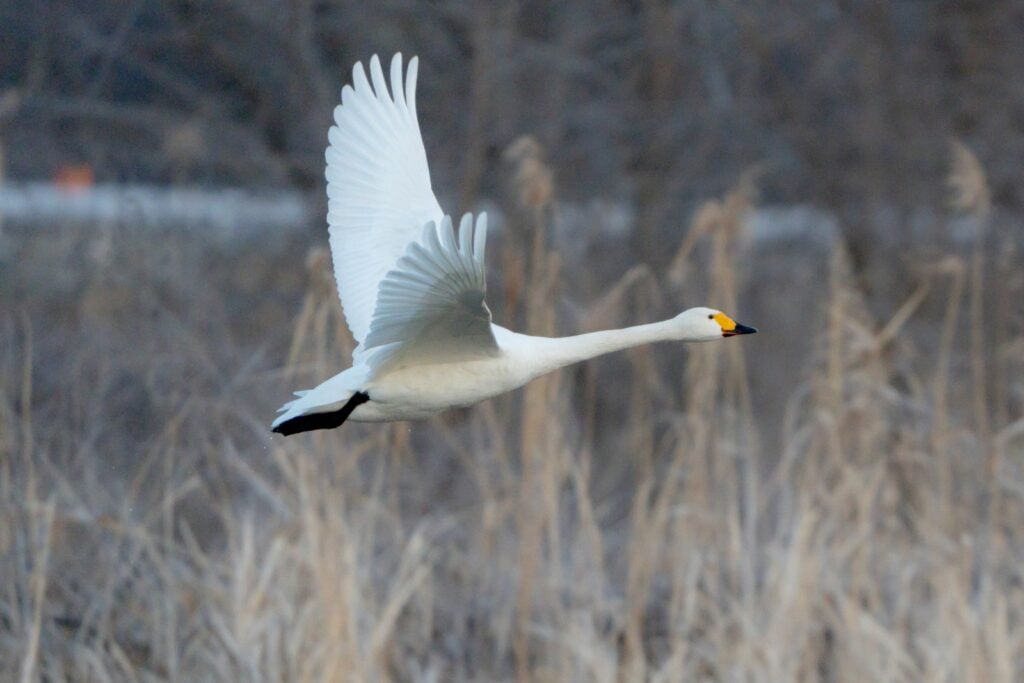
- Scientific Name: Cygnus columbianus
- Habitat: Large bodies of water across North America, Europe, and Asia
- Size: 4 to 5 feet
- Diet: Roots, stems, aquatic vegetation, seeds
Tundra swans are commonly nicknamed whistling swans because their wings make a whistling sound in flight. These widespread birds used to be separated into two species: whistling swans in North America and Bewick’s swans in Eurasia. However, further research determined that they’re the same. These birds travel across both land and water, but during the breeding season, they primarily sleep on land, while they more commonly sleep on water in the winter.
88. Turbot

- Scientific Name: Scophthalmus maximus
- Habitat: Sandy bottoms of shallow water in the Northeast Atlantic, Baltic Sea, and Mediterranean Sea
- Size: 20 to 40 inches
- Diet: Fish, crustaceans, aquatic invertebrates
Turbots are flat fish that blend into the sand. Their colors may vary between different shades of gray and brown depending on what their environment looks like. While similar fish typically catch all their prey by hiding and ambushing, turbots are surprisingly good swimmers and may chase their food down. Both of these fish’s eyes are on the left side of the body so they can see even when lying flat on the ocean floor.
89. Turkey Vulture

- Scientific Name: Cathartes aura
- Habitat: Open areas from southern Canada through South America
- Size: Wingspan of 5.5 to 6 feet
- Diet: Carrion
If you’ve seen a large bird circling in North or South America, there’s a good chance it’s a turkey vulture. They have an excellent sense of smell, allowing them to locate carcasses from high in the air. These birds can even sense dead animals beneath a tree canopy. They prefer to eat meat that’s as fresh as possible, so they avoid rotting carcasses. They have a peculiar defense mechanism that allows them to vomit on demand to scare off humans and animals.
90. Turks and Caicos Rock Iguana

- Scientific Name: Cyclura carinata
- Habitat: Rocky and sandy areas of Turks and Caicos
- Size: 16 to 32 inches
- Diet: Leaves, flowers, fruits
Turks and Caicos iguanas used to live across all parts of Turks and Caicos, but now, they only appear on some of the smaller islands. Humans, dogs, and cats have all posed a threat to this reptile’s population. While visitors love to spot these large iguanas, it’s illegal to touch and feed them in order to protect this species. They create burrows in soil and soft limestone, especially when it’s time to lay eggs.
91. Turnip-Tailed Gecko

- Scientific Name: Thecadactylus rapicauda
- Habitat: Humid, lowland forests from Mexico to northern South America
- Size: 4.7 to 8.6 inches
- Diet: Insects, spiders
The peculiar name of these geckos is because their tails often have a swollen appearance. They can store fat in their tails, and they may also wave their large tails to distract predators. Their skin is brown, but it becomes lighter during the day and darker at night to help them camouflage better. They hide in tree crevices during the day and then come out at night to hunt invertebrates like grasshoppers, cockroaches, and beetles.
92. Turquoise Dwarf Gecko

- Scientific Name: Lygodactylus williamsi
- Habitat: Tropical forests of Tanzania
- Size: 3 to 4 inches
- Diet: Small insects, nectar, fruit
Families of these bright lizards almost always live on a specific plant called the screw pine. Outside of their small groups, males can be territorial around other males. These lizards use gestures like head bobbing, tail wagging, and throat puffing to communicate with each other. Since they spend most of their time in the trees, they drink water that collects on leaves.
93. Turquoise Jay

- Scientific Name: Cyanolyca turcosa
- Habitat: Humid, montane forests from Columbia to Peru
- Size: 9.4 to 12.6 inches
- Diet: Insects, berries, eggs, young birds
Both males and females of this species have stunning turquoise feathers with a black face mask. They stay among the tree canopy when searching for food. While they typically eat insects and berries, they may eat the eggs and chicks of other bird species if the opportunity presents itself. Sometimes, other birds of the same species will help these birds build mossy nests and care for eggs.
94. Turquoise-Browed Motmot

- Scientific Name: Eumomota superciliosa
- Habitat: Woodlands from southeastern Mexico to Costa Rica
- Size: About 13 inches
- Diet: Insects, small reptiles, fruit
Turquoise-browed motmots have long, narrow tails with a blue-green racket shape at the end. Both males and females have these unusual tail feathers, which they can use to help them attract mates or deter predators. They’re social birds that travel in pairs or small groups and nest in large colonies. They make nasally croaking sounds, which are most commonly heard during the breeding season.
95. Turquoise-Fronted Amazon

- Scientific Name: Amazona aestiva
- Habitat: Forests of Brazil, Paraguay, Bolivia, and northern Argentina
- Size: 13 to 15 inches
- Diet: Fruits, seeds, nuts, berries
Turquoise-fronted Amazons, also known as blue-fronted Amazons, are noisy birds capable of mimicking human speech. They can learn up to 300 words and phrases, which could include imitations of various sounds like animal calls and human appliances. They’re monogamous birds that mate with one partner for life. Their strong beaks are perfectly adapted for breaking hard shells of nuts and seeds.
96. Twelve-Wired Bird-of-Paradise

- Scientific Name: Seleucidis melanoleucus
- Habitat: Lowland and swamp forests of New Guinea and Salawati Island, Indonesia
- Size: 13 to 14 inches
- Diet: Fruit, arthropods, frogs
Males of this species have jet back feathers with a yellow belly and wire-like tail feathers. The females look very different, with mostly brown feathers, but both males and females have red eyes. The bizarre wire feathers of the males curve upright, and they show off those feathers during mating displays. Males hop around the females, allowing the feathers to brush against potential mates.
97. Twist-Necked Turtle

- Scientific Name: Platemys platycephala
- Habitat: Shallow creeks and forests of central South America
- Size: 5.7 to 7.9 inches
- Diet: Fish, snails, amphibians, insects, worms
The name “twist-neck” comes from this turtle’s ability to twist its neck sideways to fit inside its shell. This allows them to hide from predators, even with a flat shell. They can also slide their entire body under rocks to hide if needed. They’re not the strongest swimmers, so they stick to shallow water as much as possible. They usually move by walking on the bottom of creeks rather than swimming.
98. Tyler’s Tree Frog

- Scientific Name: Litoria tyleri
- Habitat: Coastal forests of eastern Australia
- Size: Up to 2 inches
- Diet: Insects, crustaceans
Since Tyler’s tree frogs spend most of their time in the trees, they have large, sticky toe pads to make it easy for them to climb. While these frogs are normally gray-brown, males turn bright yellow when it’s time to breed, making it easy to distinguish them from females. The males call to females by making a short laughing sound, typically from dense vegetation surrounding water.
99. Typical Striped Grass Mouse

- Scientific Name: Lemniscomys striatus
- Habitat: Grasslands of Central and Western Africa
- Size: 3.7 to 5.6 inches
- Diet: Grass, leaves, roots, fruits
These tiny mice have a unique striped pattern on their backs, which features light and dark brown stripes. They live very short lives, with most mice passing away shortly after the first breeding season. On rare occasions, they can live up to four years in captivity. They’re most active during the day when they scurry around while searching for vegetation to eat.
More Animals (A-Z)
If you think there are a lot of animal species starting with T, just wait until you see how many more animals begin with other letters. For every letter of the alphabet, there’s a wide range of animals to explore. No matter how many amazing facts we learn about animals, there’s always more to discover.
A, B, C, D, E, F, G, H, I, J, K, L, M, N, O, P, Q, R, S, T, U, V, W, X, Y, Z





